For people who travel for food, few destinations stir the imagination quite like Morocco. It’s home to the colorful tagine and a dizzying number of exotic spices and seasonings. When you think of Moroccan food, you think of flavor. It’s an assault on the senses in the best ways possible.
From a tourism standpoint, Morocco needs little introduction. Year after year, it’s consistently one of the most visited countries in Africa. There are many reasons to visit Morocco but one of the best has to be the food.
If you’re the type of traveler who likes to experience a different culture through its food, then be sure to check out these 30 traditional dishes on your next trip to Morocco.
MOROCCAN FOOD QUICK LINKS
If you’re visiting Morocco and want to learn more about the cuisine, then you may be interested in joining a food tour or taking a cooking class. Check out our article on Marrakech cooking classes for recommendations.
TOURS & OTHER SERVICES
- Food Tours: Food and Wine/Drinking Tours in Morocco
- Cooking Classes: Cooking Classes in Morocco
- eSIM: Morocco eSIM
Save This on Pinterest!
No time to read this article on traditional Moroccan foods? Click on the save button and pin it for later!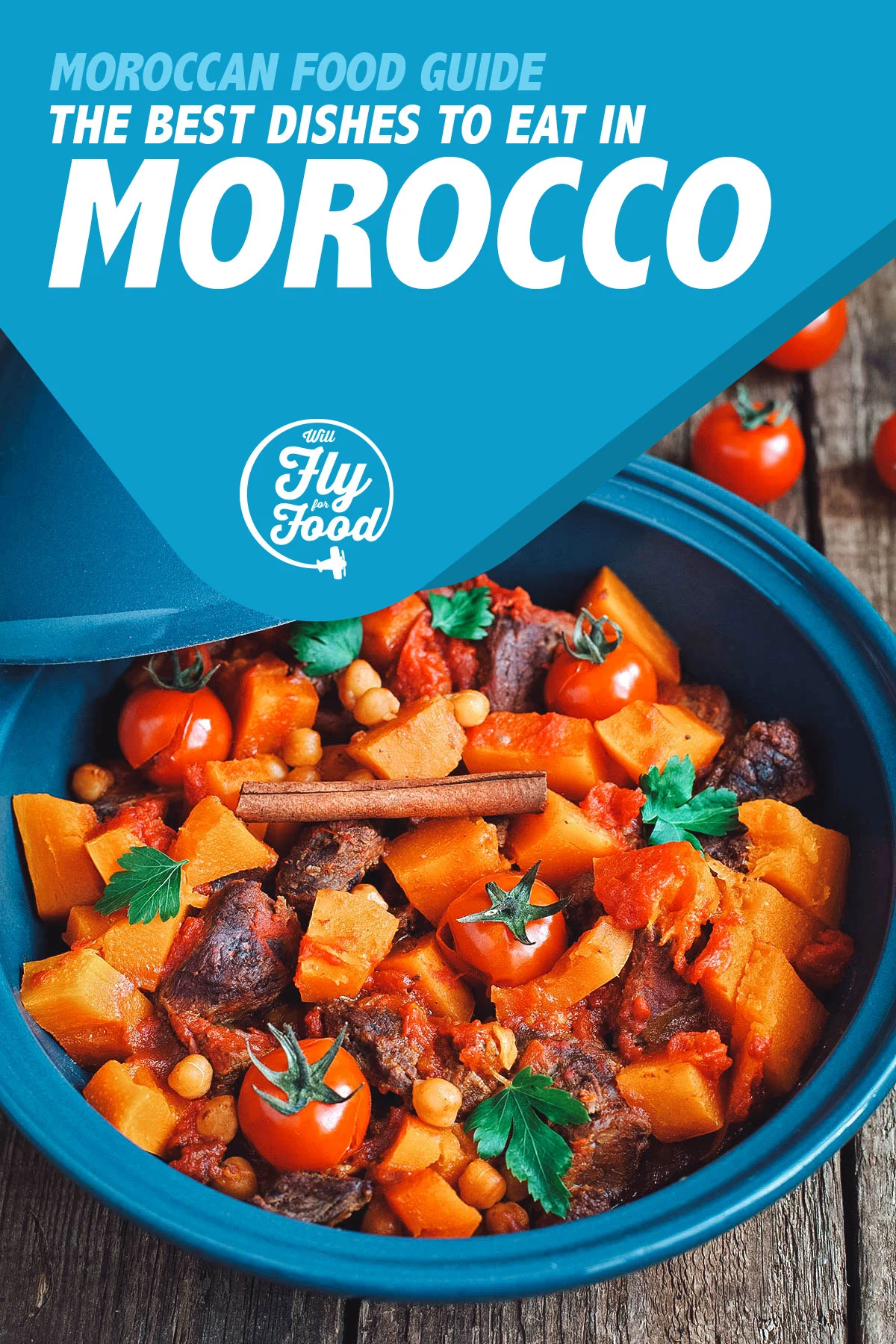
Photo by Fieryphoenix
WHAT IS TRADITIONAL MOROCCAN FOOD?
Moroccan food is a mix of many influences. It’s a blend of Berber, Andalusian, and Mediterranean cuisines with hints of European and sub-Saharan influences.
Morocco produces a wide variety of Mediterranean fruits and vegetables. Wheat is the staple grain while common meats include beef, lamb, goat, mutton, chicken, and seafood.
Savory, sweet, and sour flavors figure prominently in many Moroccan dishes. They’re typically seasoned with preserved lemon, smen (fermented butter), argan oil, olive oil, dried fruits, herbs, and a multitude of different spices.
Like India and Ethiopia, spices are used extensively in Moroccan cuisine. Some of the most commonly used spices in Moroccan cooking include cumin, turmeric, cinnamon, saffron, nutmeg, paprika, ginger, anise, and fenugreek. Ras el hanout, a popular spice blend used in many Moroccan dishes, can be made with 25-40 different spices.
With so many spices and fresh herbs used in Moroccan recipes, it’s impossible to think of Moroccan food without thinking of flavor.
THE BEST MOROCCAN DISHES
This article on Moroccan foods has been organized by category to make it easier to digest. Click on a link to jump to any section of the guide.
STARTERS / SOUPS / SIDES
1. Couscous
What better way to start this Moroccan food guide than with couscous, Morocco’s national dish? It refers to a widely consumed Maghrebi dish of small durum wheat semolina granules. It’s a staple food in many North African countries like Morocco, Tunisia, Algeria, Mauritania, and Libya.
In modern times, the production of couscous is largely mechanized but it’s traditionally made by sprinkling semolina with water and rolling it by hand to form small pellets. The pellets are then sprinkled with flour to keep them separate before being sieved. Any pellets that fall through are rolled again until they achieve the proper size.
As you can imagine, the traditional preparation of couscous is a labor-intensive process. Groups of people would work together to create large batches that would last for several months. They’d form the balls of couscous then leave them out to dry in the sun. When ready for consumption, the couscous would be steamed and rehydrated in a couscousiere until the desired consistency was achieved.
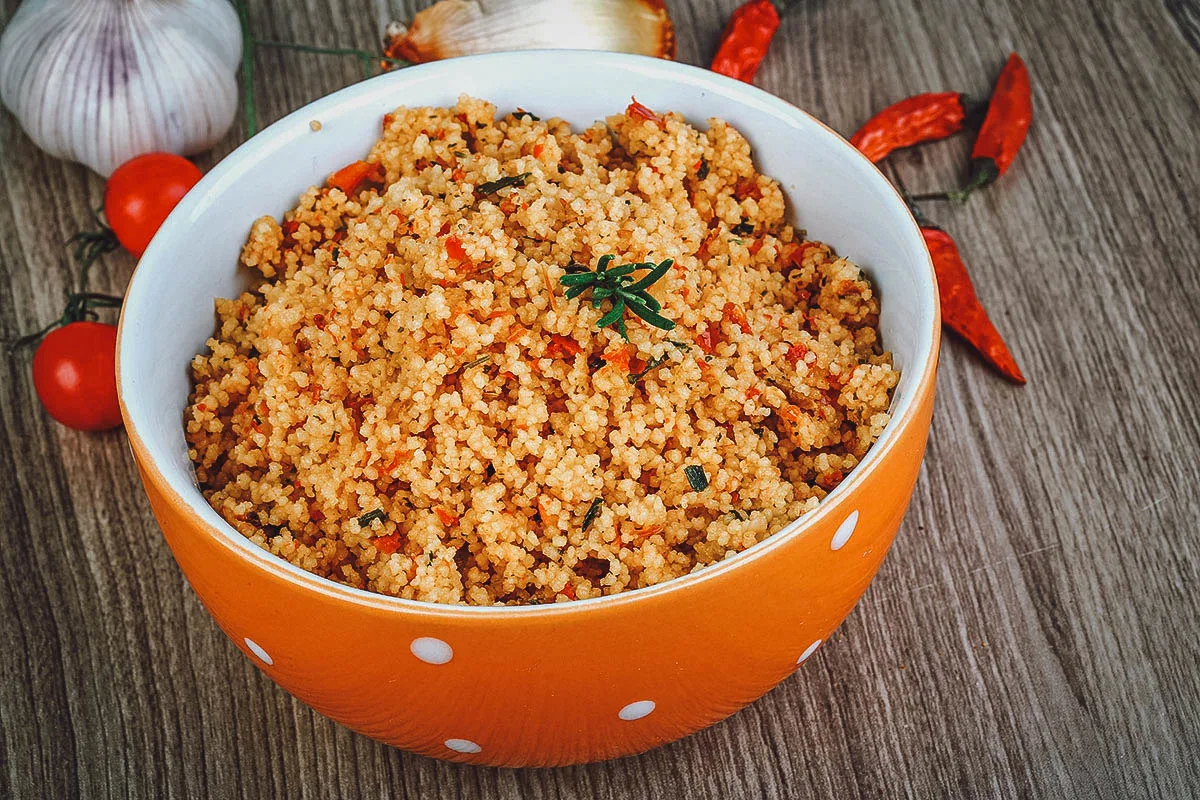
Photo by AndreySt
Couscous is typically served in a large earthenware bowl or plate with a meat or vegetable stew spooned on top. It’s a communal affair with diners gathering around the plate to enjoy the meal. You’re meant to eat only the portion of food directly in front of you, so hosts would often place the choicest cuts of meat in front of esteemed guests.
Like Ethiopians, Moroccans traditionally eat using only their right hand. The left hand is used to perform hygienic duties and is thus considered unclean. It’s used only to pick up bread or to pass dishes to other guests.
To eat, a portion of couscous is gathered using the thumb and fingertips and then pressed into a ball and consumed. No matter how good it is, remember to use only your thumb and first two fingers when gathering couscous. In Moroccan culture, using any more is considered gluttony.
Interestingly, Friday is the traditional day to eat couscous in Morocco. Friday is a Muslim holy day and the equivalent to a Sunday in Christian cultures. After prayers, families would sit down to a large meal of couscous and stew made with seven vegetables – eggplant, carrots, zucchini, pumpkin, parsnips, tomatoes, and cabbage.
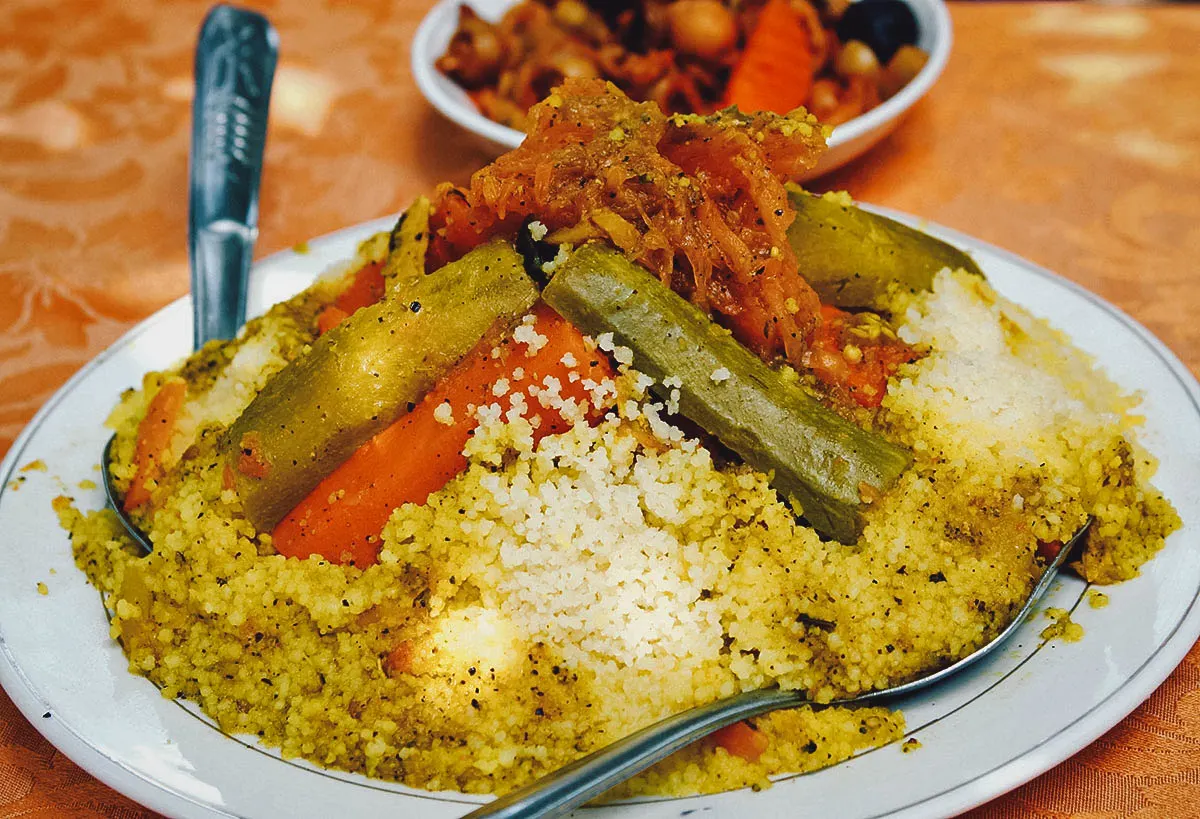
Photo by evp82
2. Shakshuka (Berber Omelette)
Shakshuka (or shakshouka) refers to a popular Mediterranean breakfast dish of poached eggs cooked in a tomato sauce with peppers, garlic, onions, olive oil, and spices. Popular throughout North Africa and the Middle East, its name translates to “mixture” and is believed to be either Tunisian or Yemeni in origin.
Shakshuka is a one-pan dish that can be prepared in many ways. It’s typically made with poached eggs though it can be made with scrambled eggs as well similar to a Turkish menemen. Recipes vary but common spices include ground coriander, paprika, cumin, and cayenne pepper. Some versions may include other ingredients as well like preserved lemon, sheep milk cheese, olives, harissa, sausage, and minced lamb.
Shakshuka is typically served in the pan in which it was cooked, often with crusty Moroccan bread which is meant to be dipped into the tomato sauce and runny poached egg.
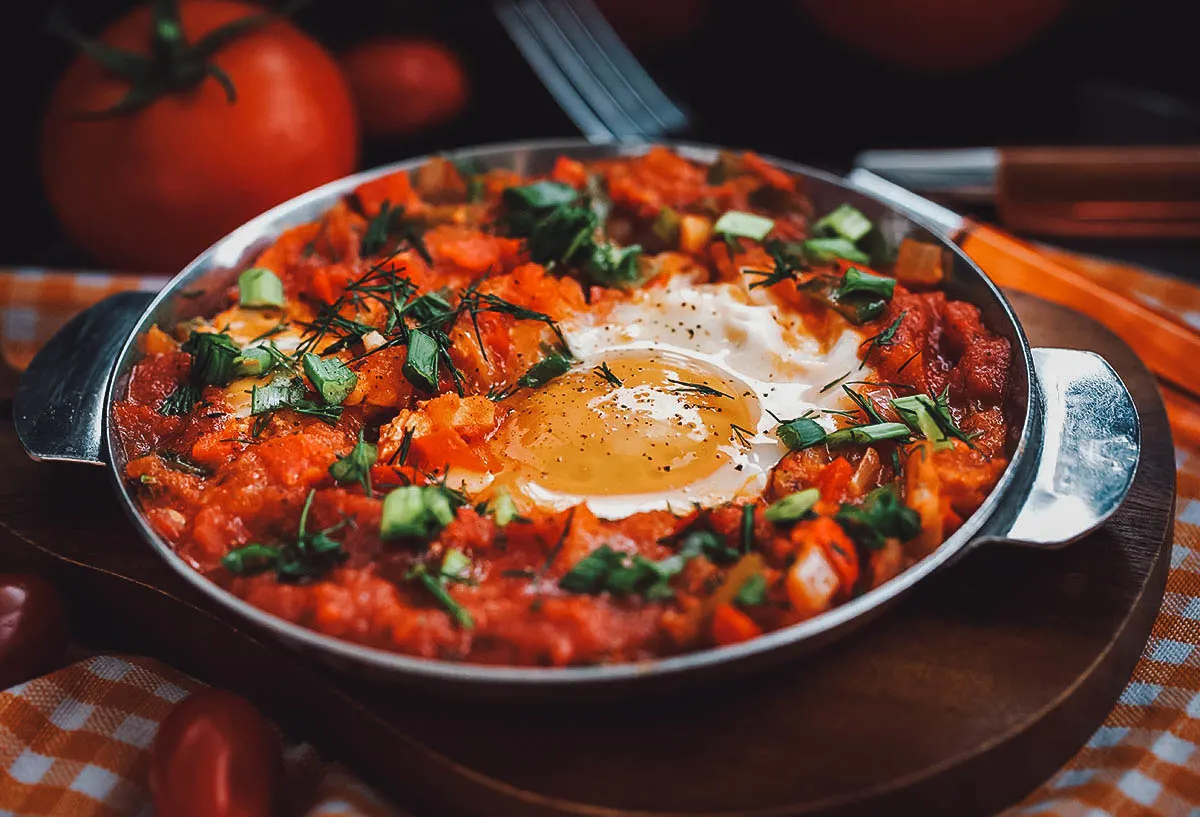
Photo by AndreySt
3. Taktouka
Similar to shakshuka, taktouka refers to a Moroccan salad made with tomatoes, roasted bell peppers, olive oil, paprika, and fresh parsley. It’s essentially a less saucy and milder-tasting version of shakshuka made without eggs.
Unlike shakshuka that’s typically enjoyed for breakfast, taktouka is served as a side dish to grilled meat and fish dishes or as a dip with bread.
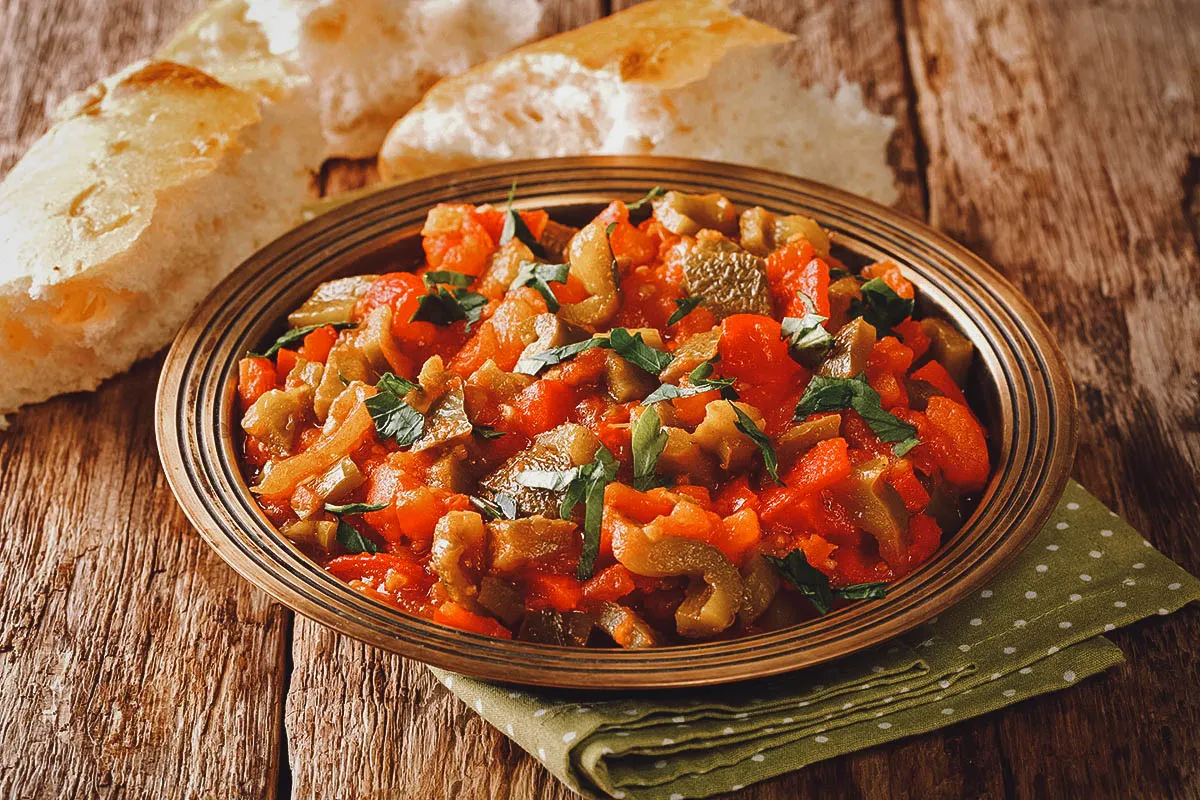
Photo by lenyvavsha
4. Zaalouk
Zaalouk is a popular Moroccan dip made with eggplant, fresh tomatoes, garlic, olive oil, and spices and herbs like cumin, paprika, parsley, and cilantro. Like taktouka, it’s typically served as a dip with crusty bread or as a side dish to Moroccan fish, chicken, or meat dishes.
Preparations for zaalouk vary but the best versions are made with roasted eggplant. It adds a wonderful smokiness and another layer of flavor to the dish.
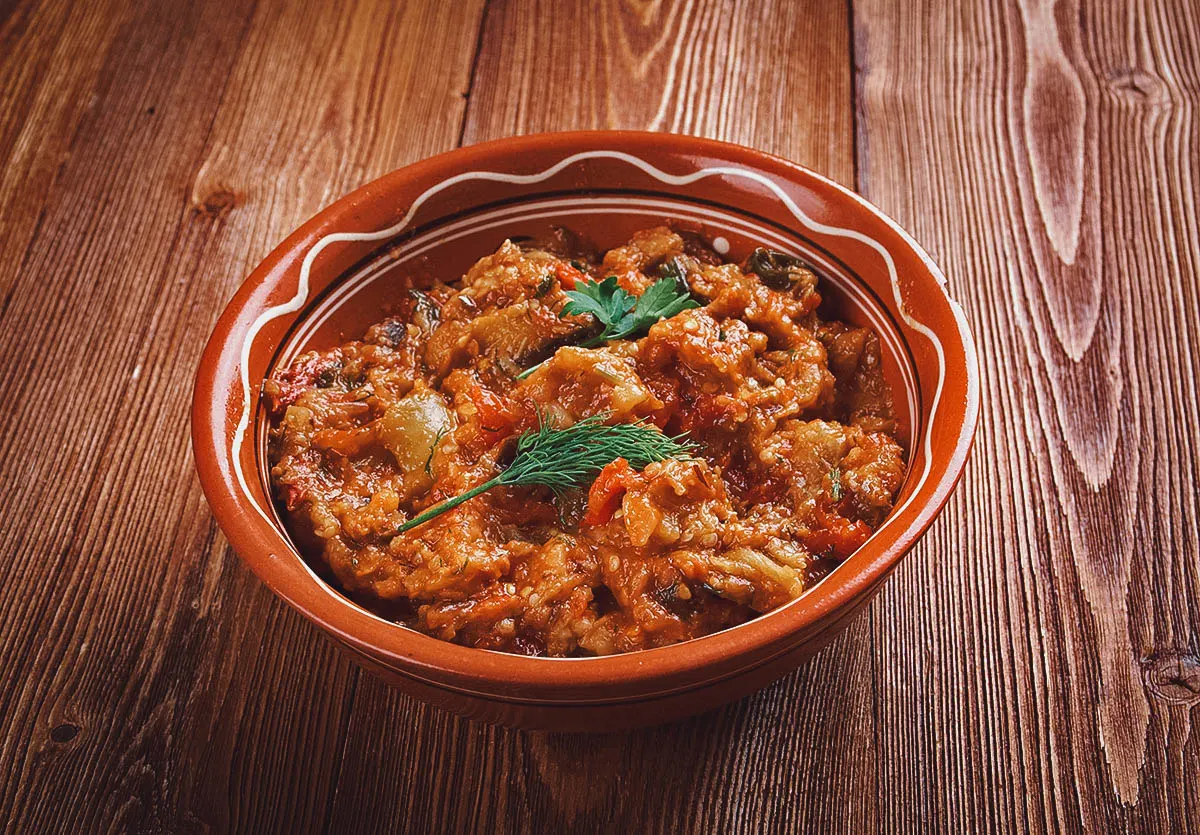
Photo by fanfon
5. Maakouda
Maakouda refers to a type of potato fritter made with deep-fried mashed potatoes mixed with sautéed onions, garlic, cumin, and cilantro. It’s originally an Algerian dish that’s become popular in Morocco and Tunisia as well.
Maakouda can be enjoyed in many ways. It can be eaten as an appetizer, as a side dish, or as a filling for sandwiches. It’s often served as street food in Morocco and becomes especially popular during the month of Ramadan.
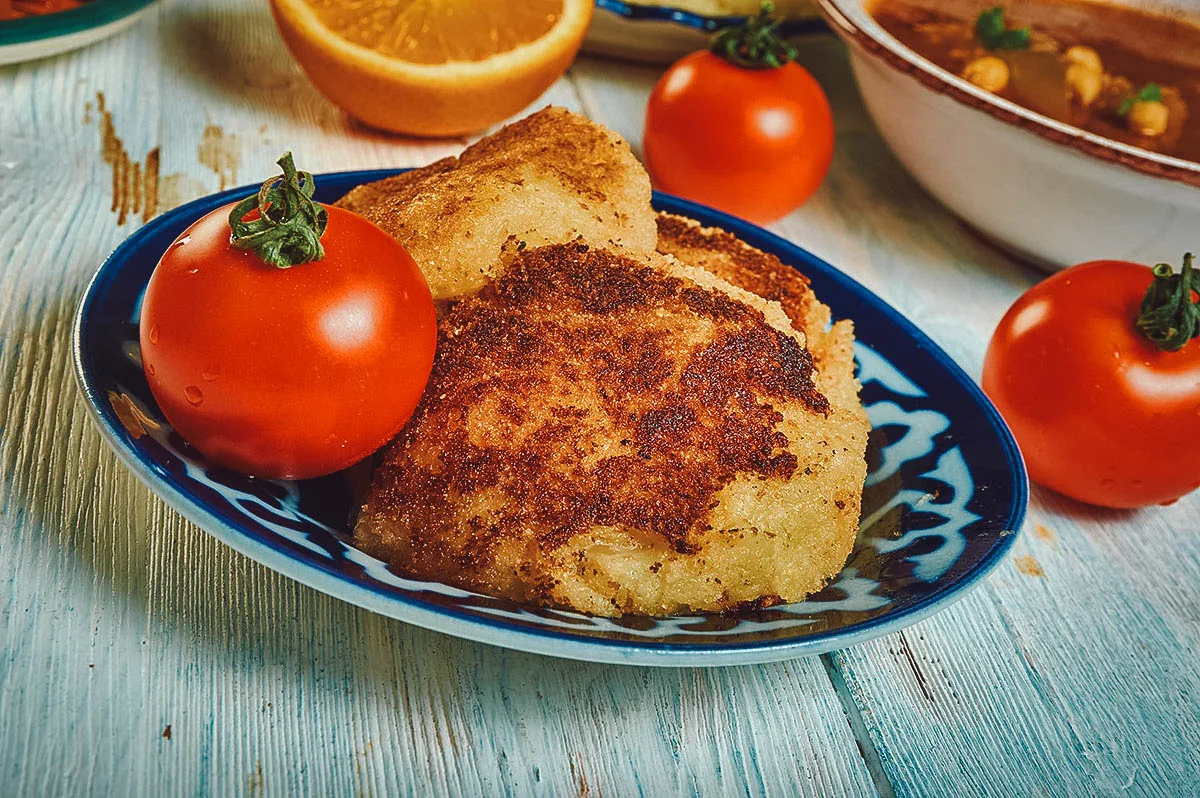
Photo by fanfon
6. Harira
Harira is a zesty tomato-based lentil and chickpea soup popular in the cuisines of Morocco and Algeria. It can be consumed at any time of the year though it becomes especially popular during Ramadan when it’s served to break the fast.
Recipes for harira vary from cook to cook but it’s typically made with tomatoes, chickpeas, lentils, onions, rice (or vermicelli), eggs, flour, herbs, and spices. The name harira is derived from the Arabic word for “silk” and refers to the consistency of the soup after it’s been thickened with eggs or a tedouira mixture of flour and water.
The stock can be flavored with beef, lamb, or chicken, though these ingredients can be omitted altogether to make a vegetarian version of the soup. Rice or vermicelli are often added as fillers while common seasonings include cilantro, parsley, ginger, cinnamon, and turmeric.
As described, harira is one of the main dishes served for iftar, the evening meal that breaks the fast. Like chebakia (Moroccan pastry), it’s served almost everyday in every Moroccan household during the month of Ramadan.
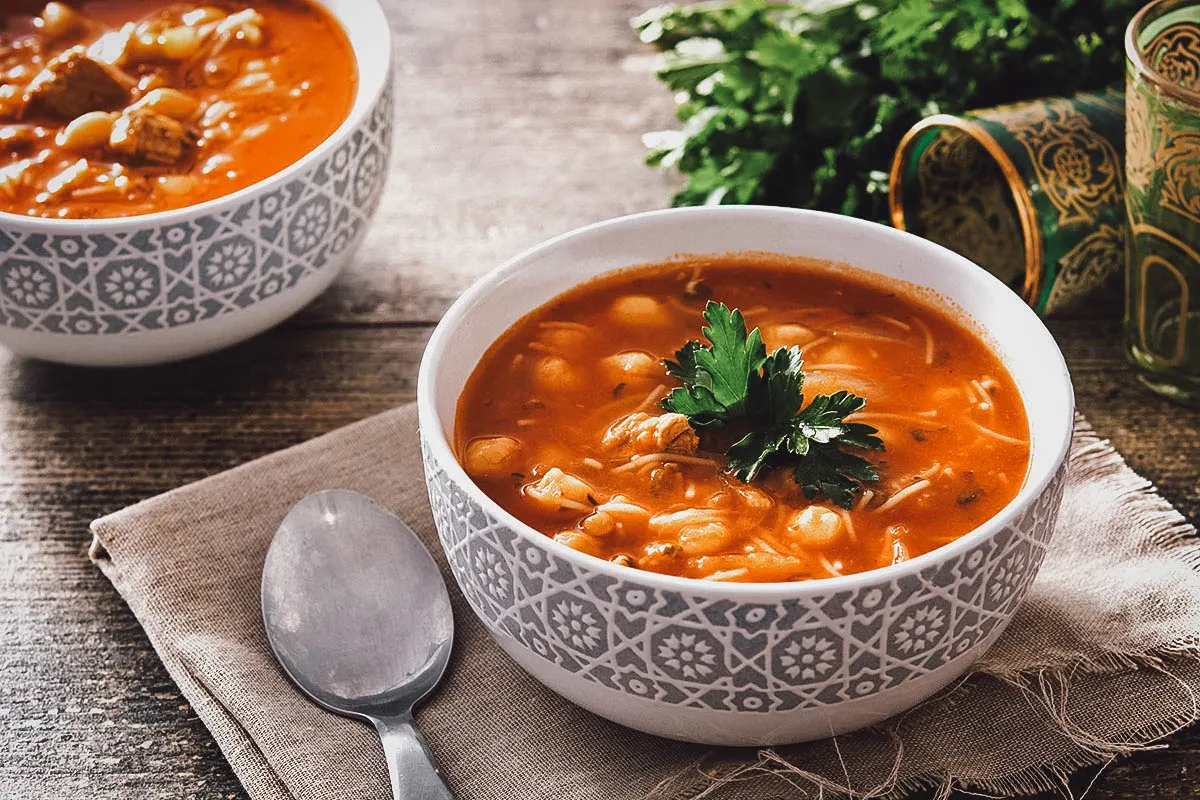
Photo by etorres69
7. Bissara
Bissara (or bessara, besarah) refers to a traditional North African soup made with dried and puréed split fava beans or split peas. It’s originally from Egypt though it’s become popular in Morocco as well, especially in the northern part of the country where it’s often served on its own or as a side dish to fish.
To prepare, the legumes are simmered with garlic, cumin, cayenne pepper, paprika, and olive oil before being puréed to a smooth consistency. It can be enjoyed in different ways depending on how thick it is. Thinner bissaras are eaten as soups while thicker versions are enjoyed as a dip with crusty Moroccan bread.
Often sold as street food in Morocco, bissara is a hearty and comforting dish that’s typically consumed during the winter months.
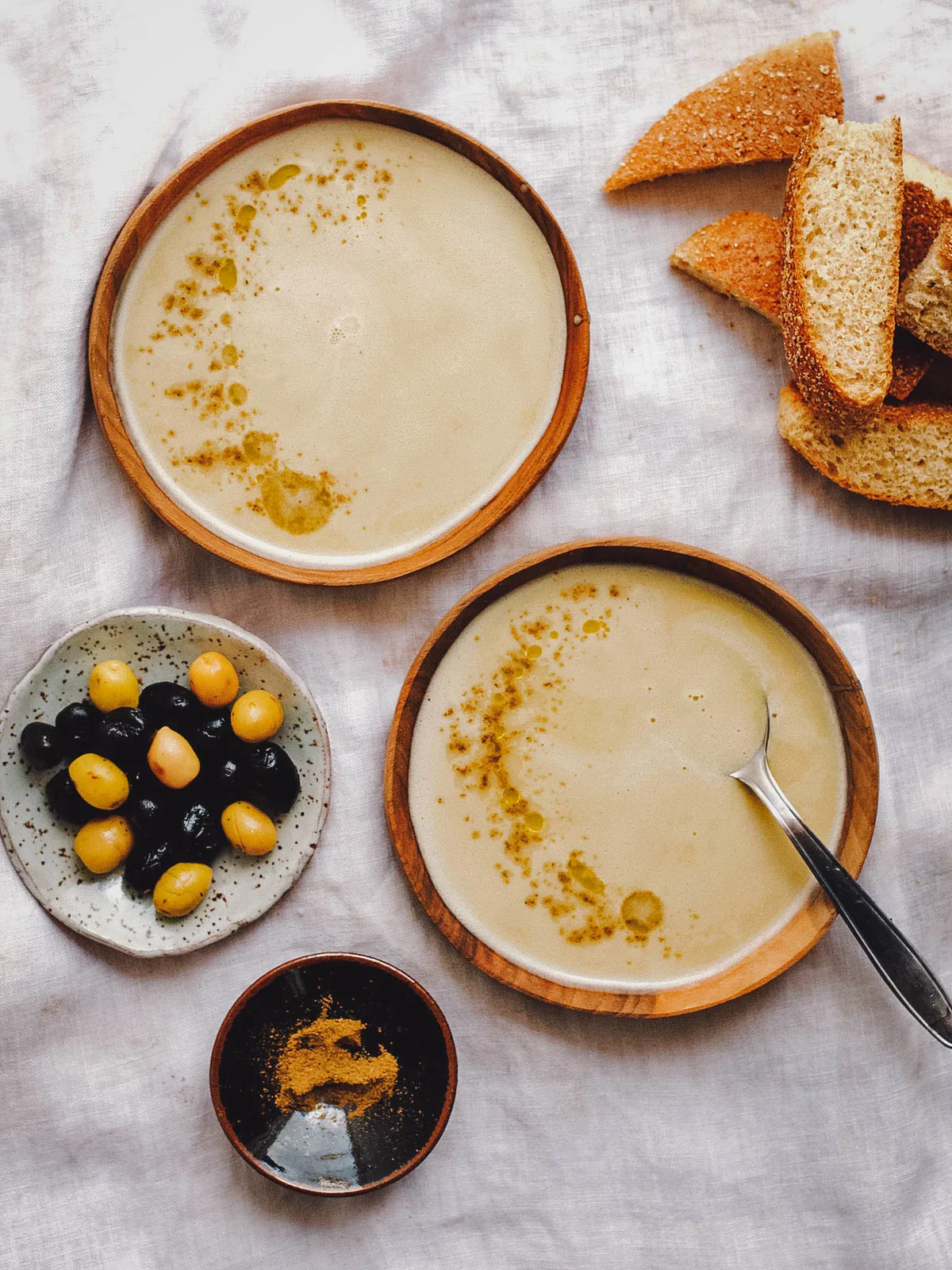
Photo by Ruby Josephine Smith, CC BY-SA 4.0, via Wikimedia Commons / Processed in Photoshop and Lightroom
8. Briouat
Briouats (or briwat) are small Moroccan pastries made with a variety of fillings wrapped in a paper-thin Moroccan dough called warqa. They can be baked or fried, sweet or savory, and rolled in triangular or cylindrical form.
Pictured below are savory briouats. Recipes vary but they’re typically made with meat (usually lamb, beef, or chicken), cheese, onions, and various herbs and spices like cilantro, parsley, cumin, paprika, cinnamon, and pepper.
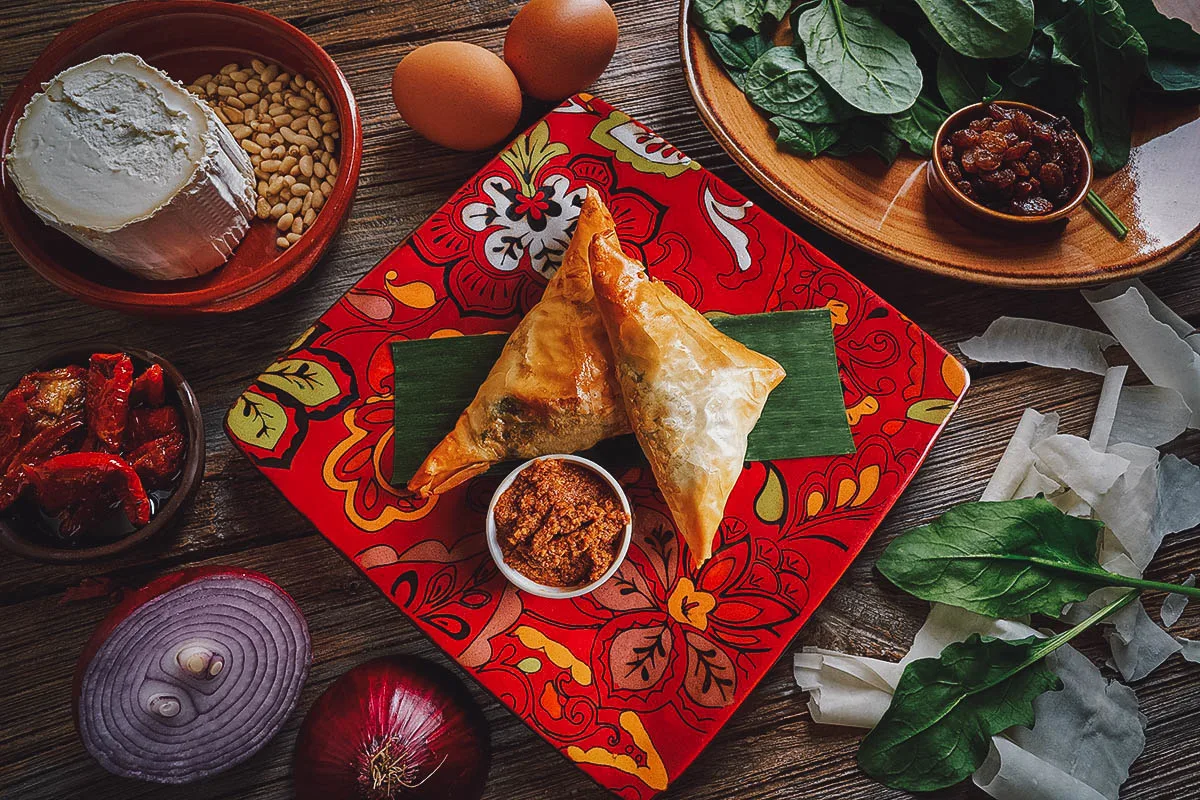
Photo by lunamarina
Pictured below are almond briouats. Coated in warm honey and sesame seeds, they’re filled with almond paste flavored with cinnamon and orange flower water.
Almonds briouats are enjoyed throughout the year in Morocco, often with tea, though they become especially popular during Ramadan. Families would make large batches of almond briouats leading up to Ramadan and then serve them throughout the month with other Moroccan sweets like chebakia and sellou (roasted flour dessert).
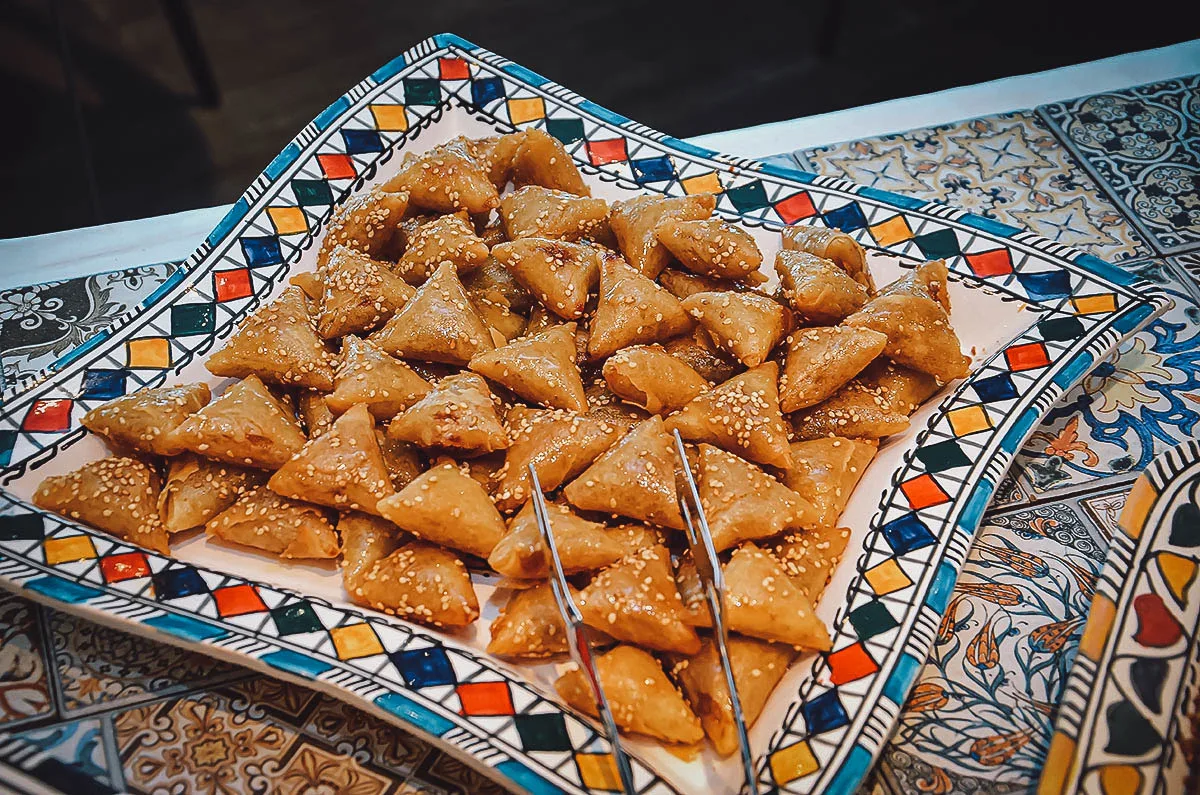
Photo by azarbico
BREADS / PANCAKES
9. Khobz
Spend a day in Morocco and it becomes evident how important bread is to Moroccan cuisine and culture. Bread for Moroccans is what rice is to people from Southeast Asia. It’s consumed at almost every meal and functions both as food and as a vessel for scooping up Moroccan dips, salads, tagines, entrees, and side dishes.
There are many different types of bread in Morocco but the most common is this round loaf called khobz. Often referred to as force, in reference to the French word for strong white flour, khobz (or kesra, agroum) is a disc-shaped type of crusty white bread with a coarse interior and texture. It’s a versatile everyday bread that can be used as a scoop for Moroccan foods or as vessel for grilled meats and other sandwich fillings.
Khobz is sometimes described as flatbread but it’s thicker than your average flatbread. Thicknesses vary between bakers but many Moroccans prefer their khobz to be between 1.5-3 cm thick (0.6-1.3 in). They can be made into small personal-sized loaves or baked into larger family-sized rounds measuring 30 cm (12 in) in diameter.
Khobz is readily available at neighborhood bakeries and shops though many Moroccan families still prefer to make it from scratch (khobz dyal dar). They’ll bake it in home ovens or in communal wood-fired ovens known as ferran.
For breakfast, Moroccans like to have khobz with honey and soft cheese or dipped in olive oil. For lunch and dinner, it makes the perfect accompaniment to soups and tagines. Bread is considered sacred in Morocco and rarely wasted or thrown out.
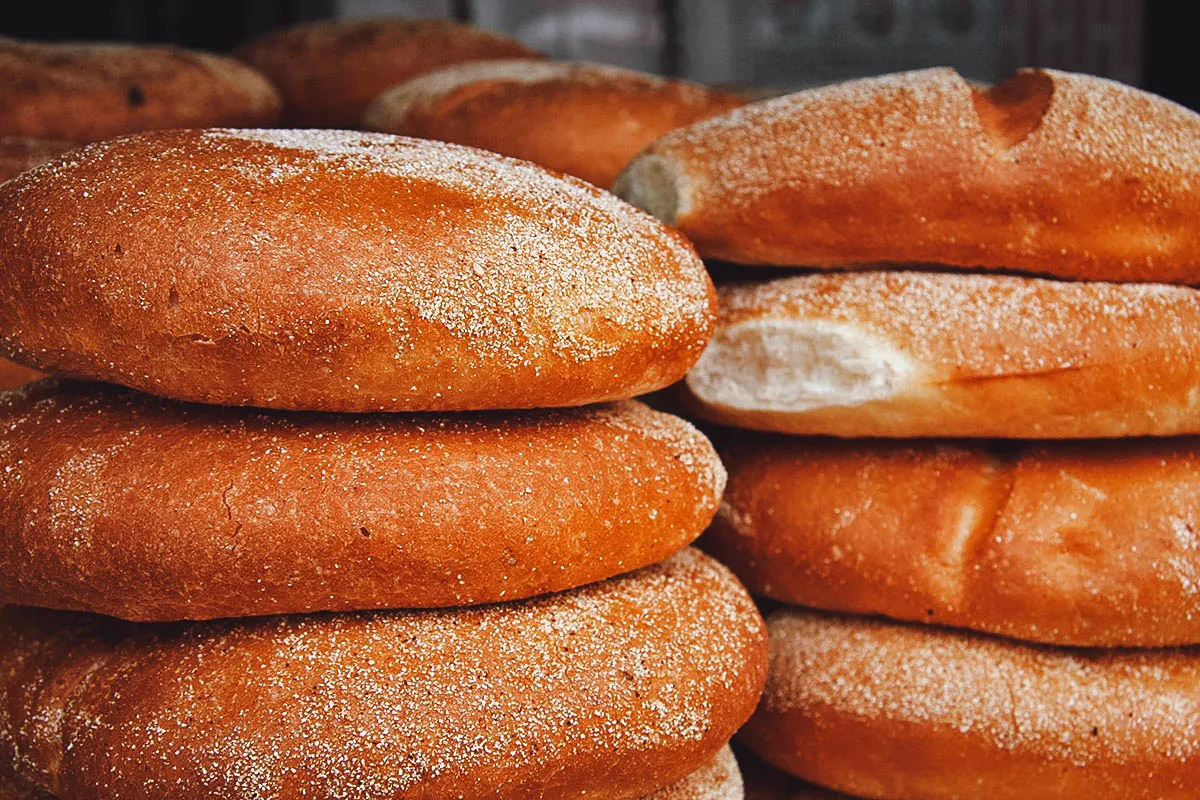
Photo by Hagen411
10. Batbout
Batbout (or mkhamer, toghrift, matlou‘) refers to a type of Moroccan flatbread. Made with semolina, white flour, and whole wheat flour, it’s basically the Moroccan equivalent to the Middle Eastern pita except it’s cooked on a stove top instead of being baked in an oven.
Batbout is a versatile bread that can be made into different sizes. Like pita, it contains a pocket and is often used as a vessel to hold different sandwich ingredients. On its own, it’s typically eaten for breakfast with butter, honey, or jam or served as a side to grilled meat dishes.
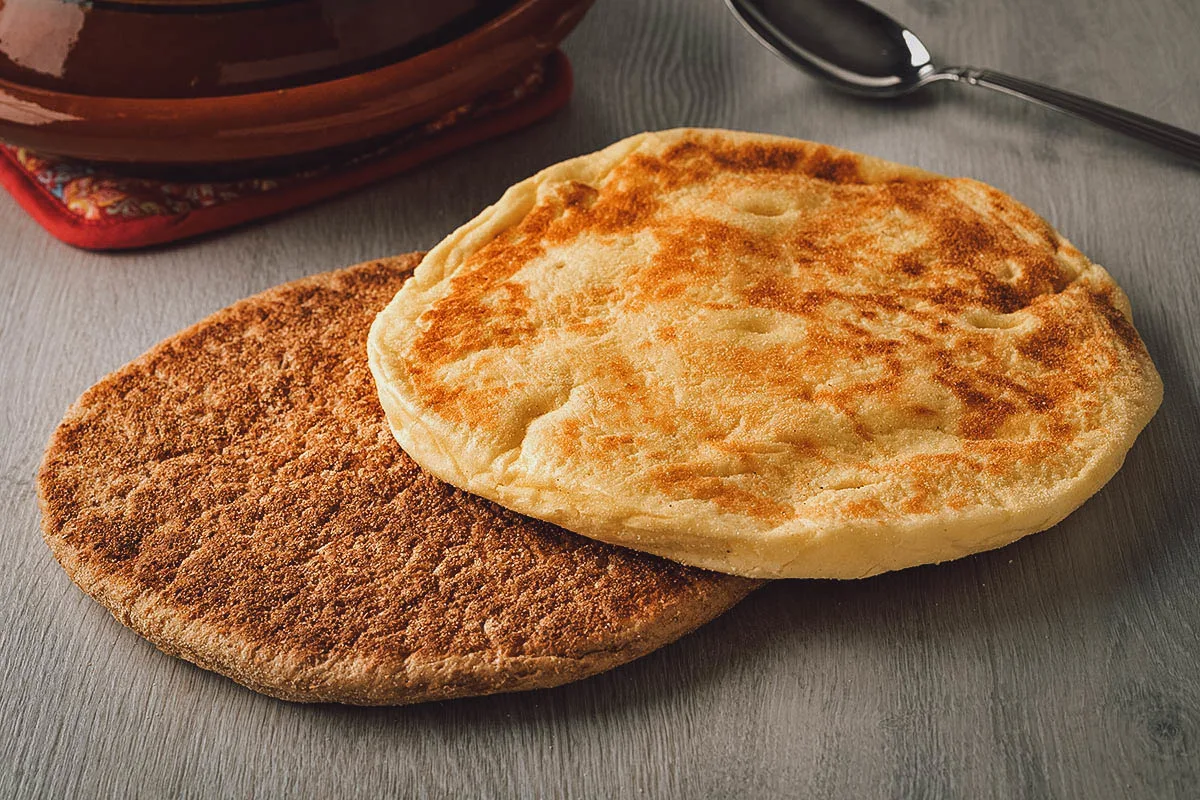
Photo by picturepartners
11. Msemen
If you like crepes or pancakes, then you’ll surely enjoy msemen as well. Common in Morocco, Tunisia, and Algeria, this thin flaky flatbread with multiple layers is a popular breakfast dish and street food in Morocco. You can think of it as the Moroccan version of Indian paratha, Singaporean roti prata, or Malaysian roti canai.
Msemen (or rghaif) is made with a dough consisting of flour, durum wheat semolina, soft butter, dry yeast, salt, sugar, and water. The dough is cut into balls which are rolled out and formed into thin circles. The sides are then folded into a square, while sprinkling with semolina and butter, to create the signature layers of dough. The square-shaped dough is patted flat and cooked on a griddle or frying pan on both sides till golden brown and crispy.
Msemen can be savory or sweet and is often enjoyed for breakfast or as a snack with tea or coffee. When eaten for breakfast, they’re traditionally paired with a hot honey and butter dipping sauce. Savory versions of msemen are often stuffed with various ingredients like ground meat (usually beef or lamb), onions, herbs, and spices.
Like khobz, msemen is readily available at bakeries or from street food stalls but many Moroccans still prefer to make it at home.
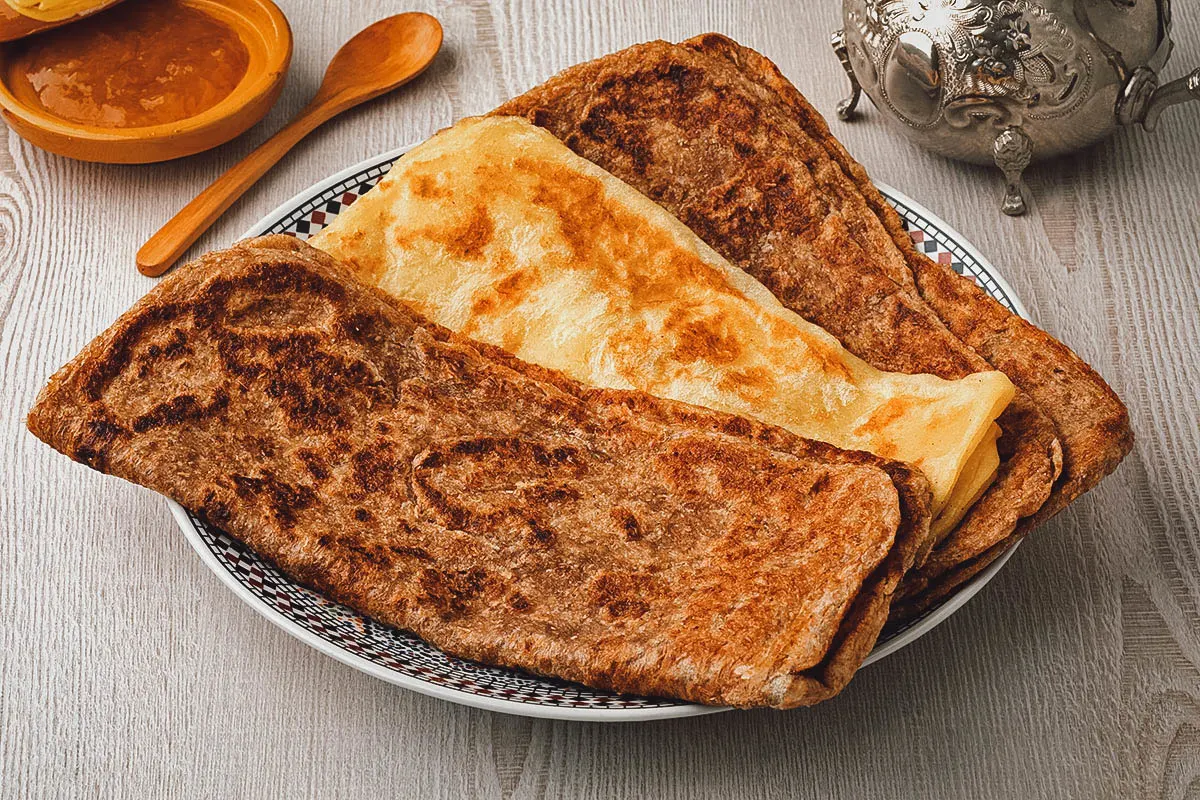
Photo by picturepartners
12. Meloui
Meloui refers to a type of Moroccan laminated pancake or crepe that’s very similar to msemen. Meaning “rolled” in Arabic, the main difference is in its shape. Unlike msemen which is formed into a square, meloui is shaped into a coil or roll before being flattened and cooked on a stove top.
Another difference is that meloui is made with more semolina which gives it a different taste and texture to msemen. When done correctly, you can pull the bread apart from its outer edges and uncoil it towards the center. Like msemen, its typically consumed for breakfast with butter and honey or as a snack with tea.
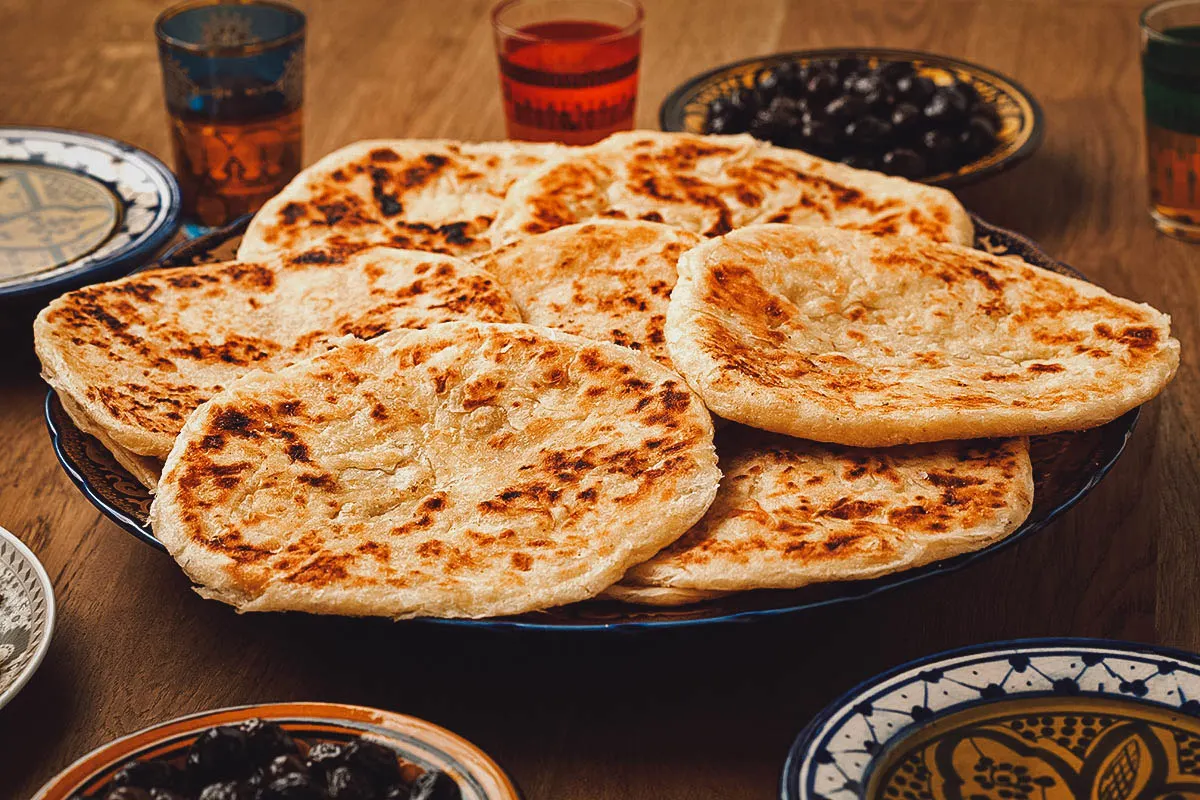
Photo by picturepartners
13. Baghrir
One look at this popular Moroccan pancake and it becomes obvious why it’s called “thousand hole pancakes”. Made with semolina, baghrir are small spongy pancakes known for their many tiny holes that form during the cooking process.
Popular in the cuisines of Morocco and Algeria, baghrir pancakes are made with a crepe-like batter consisting of flour, fine semolina, baking powder, yeast, salt, sugar, and water. It’s the yeast in the batter that creates the holes in the pancake.
As soon as the batter hits the pan, hundreds of bubbles form and break the surface of the pancake as it cooks, giving baghrir its unique texture and appearance. Unlike western pancakes, baghrir is cooked only on one side making it quicker and easier to make.
Baghrir is traditionally paired with a honey-butter syrup and eaten for breakfast. They’re also a common part of iftar meals during Ramadan. The holes may trigger trypophobia in some people but they actually work well in trapping and absorbing the syrups and jams paired with the pancakes.
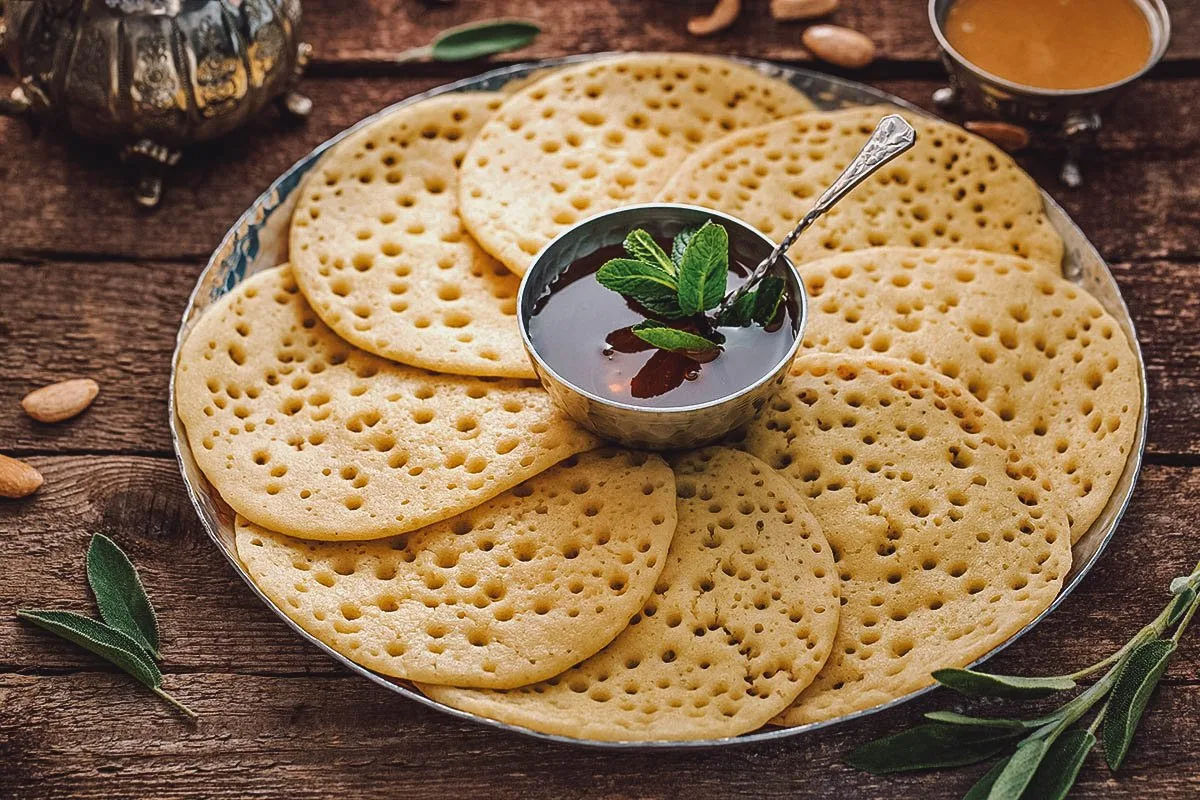
Photo by kopachinsky
14. Moufleta
It was interesting to learn that North Africa is home to the second largest Jewish diaspora group in the world. Maghrebi Jews have lived in the region for over 2,000 years, long before the arrival of Sephardic Jews. Like any culture, they have their own set of customs and celebrations, one of which is Mimouna.
Mimouna is a celebration dinner that’s held the day after Passover in parts of the world with a large Maghrebi Jewish population like Morocco, Israel, France, and Canada. It’s celebrated to mark the return to eating hametz, which are foods made with leavening agents like leavened bread, pancakes, and cookies – all of which are forbidden throughout the week of Passover.
Moufleta (or mofletta, mufleta) is one of the standard dishes served during Mimouna. It refers to a simple Maghrebi Jewish crepe made with flour, water, and oil. It’s usually served warm and enjoyed with butter, honey, syrup, jam, nuts, and dried fruits.
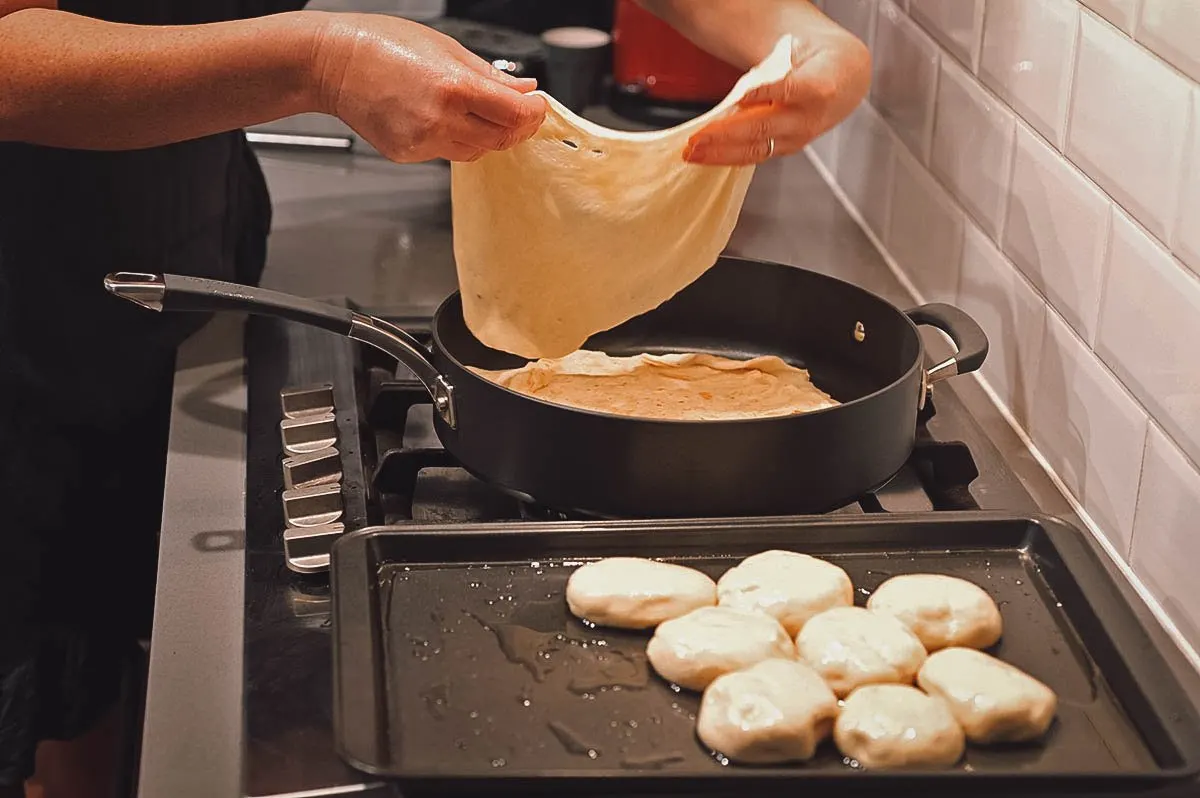
Photo by lucidwaters
15. Harcha
Harcha (or ḥarša) is a type of pancake or pan-fried bread made with semolina. Popular in Morocco and Algeria, it’s name means “rough” in Arabic and is in reference to the bread’s coarse and crispy exterior derived from semolina.
To make harcha, a dough consisting of semolina, baking powder, butter, milk, salt, and sugar is shaped into balls and rolled in coarse semolina. The balls are then formed into rounds and cooked on a griddle on both sides till they achieve a light golden brown color. They can be made into small individual cakes or into larger rounds shared between many.
When cooked, harcha looks a bit similar to English muffins though they’re closer in taste and texture to cornbread. They’re typically eaten for breakfast or as a snack with mint tea, usually with jam, cheese, or honey-butter syrup. Like baghrir, it’s a common snack during Ramadan.
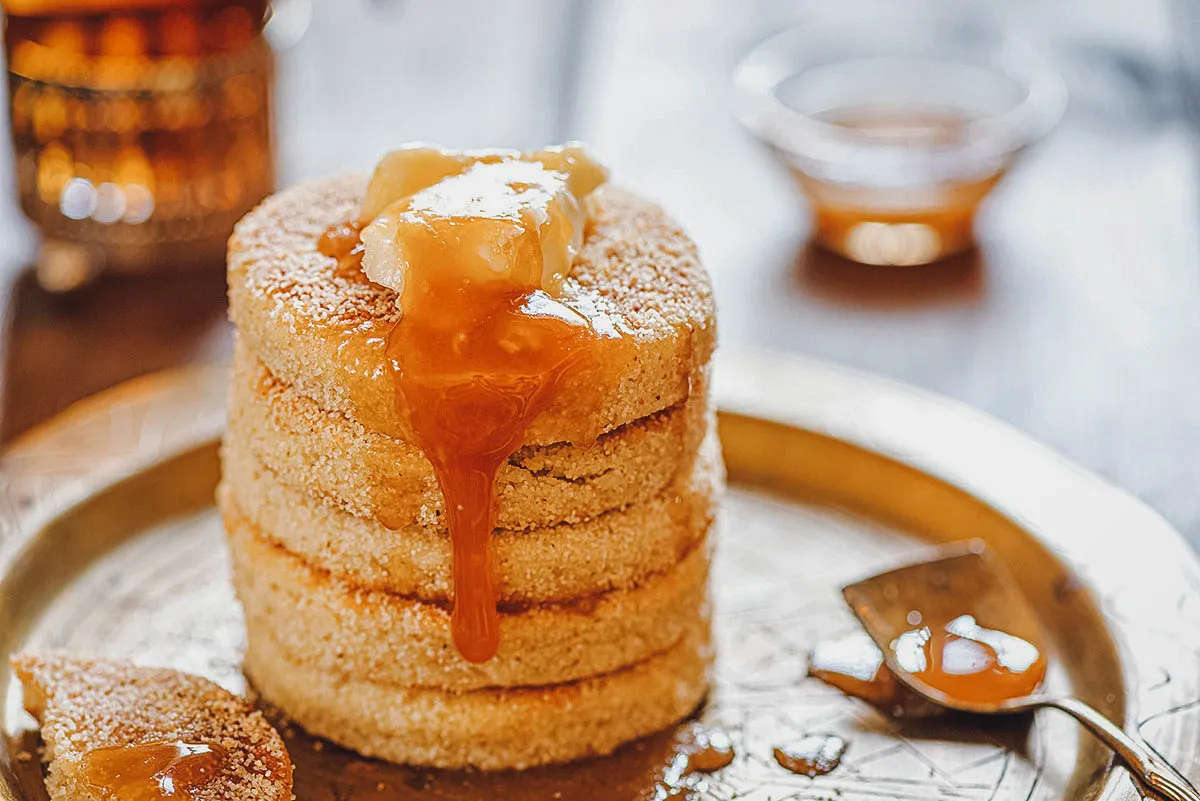
Photo by [email protected]
16. Krachel
Krachel (or el gors) refers to a sweet Moroccan bread roll made with a yeasted brioche-like dough enriched with aniseed and orange blossom water. Fragrant and aromatic, they’re brushed with egg wash and dusted with sesame seeds before being baked to a deep golden brown.
Like many of the breads in this Moroccan food guide, krachel is commonly eaten for breakfast or as a snack with Moroccan tea, either on its own or with various spreads like butter, jam, or cheese. It can also be part of an iftar meal to break the fast during Ramadan.
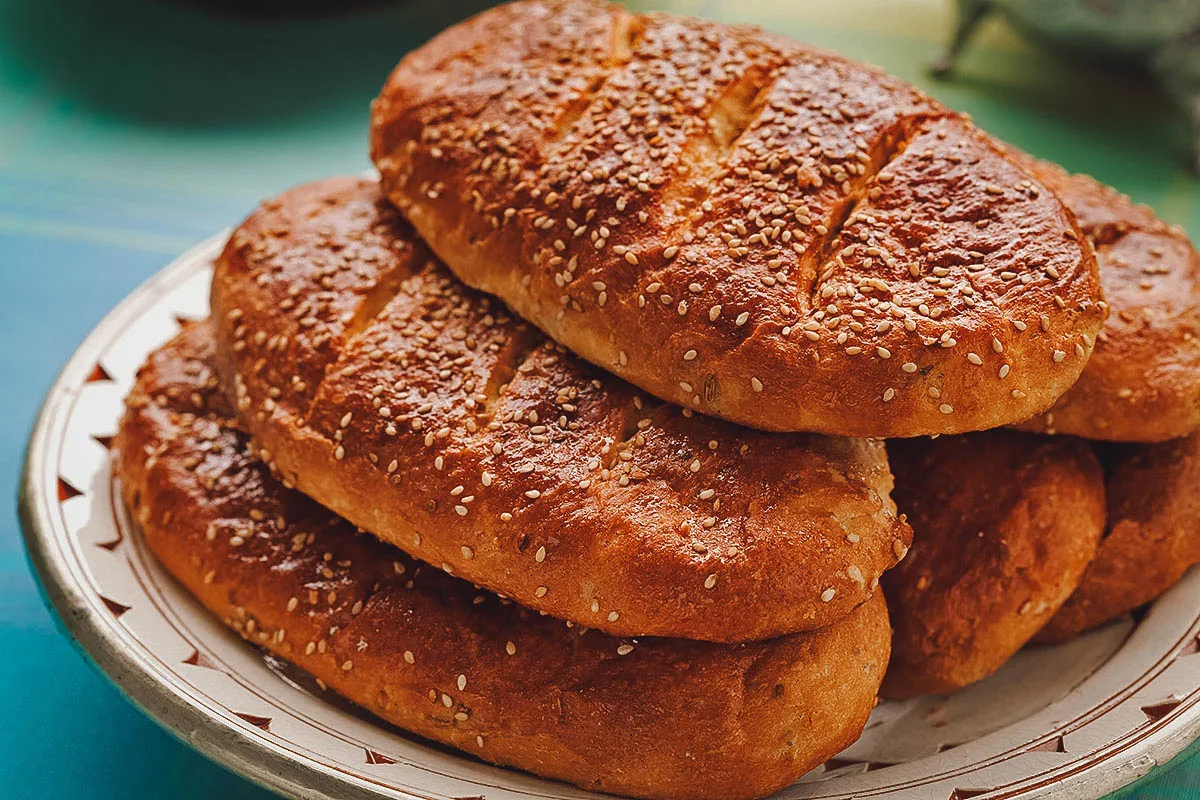
Photo by picturepartners
MEAT / POULTRY / SEAFOOD
17. Tagine
After couscous, tagine is the most well-known dish in Moroccan cuisine. It’s also the most striking because it can refer to both the Berber dish and the unique (and often colorful) cooking vessel used to make it. The word tagine stems from the Berber word tajin, meaning “shallow earthen pot”.
When referring to the cookware, a tagine (or tajine) is a ceramic or clay pot consisting of two parts – a flat circular base used for cooking and serving and a distinctively shaped conical lid. It comes in different sizes and can be glazed or left as is. Cooks generally preferred unglazed tagines because of the earthy flavors they impart to cooked dishes.
The tagine’s cone-like shape is designed to trap steam and return the condensed moisture back down to the dish simmering below. This reduces the amount of water needed to slowly cook and tenderize tougher cuts of meat. Not only does it keep the meat as moist and tender as possible, but it’s a practical method of cooking in areas where water supplies are limited.
A tagine can be used to slow-cook Moroccan stews made with meat, poultry, fish, vegetables, and fruit. Known for their sweet and sour flavor profiles, spices commonly used in tagine dishes include turmeric, saffron, paprika, cumin, cinnamon, and ginger. Fresh herbs are often incorporated into recipes along with other ingredients like olives, preserved lemon, nuts, and dried fruit.
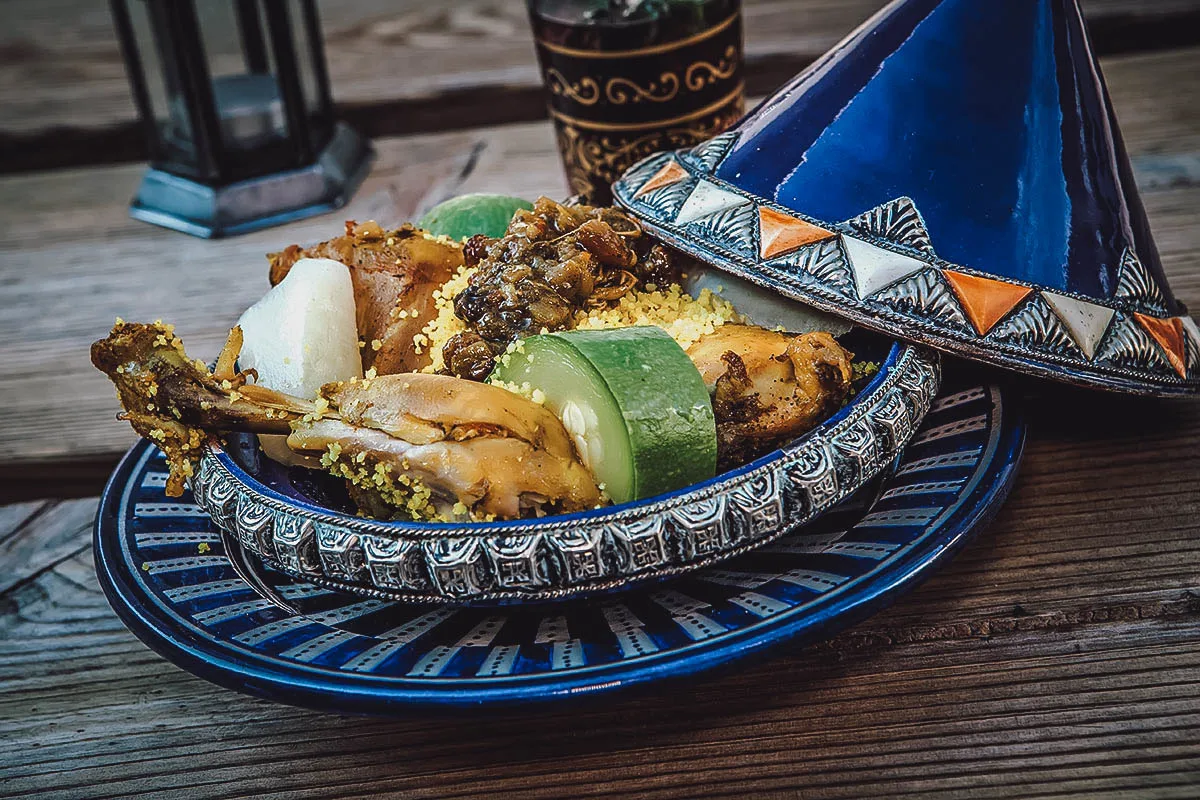
Photo by trexec
Pictured below is kefta tagine, a popular type of tagine made with spiced beef or lamb meatballs cooked in a zesty shakshuka-like tomato sauce. Served with Moroccan bread, it’s often made with eggs poached directly in the sauce.
No matter what it’s made with, tagine is definitely one of the best dishes to try when visiting Morocco. You can’t leave Morocco without trying it at least once!
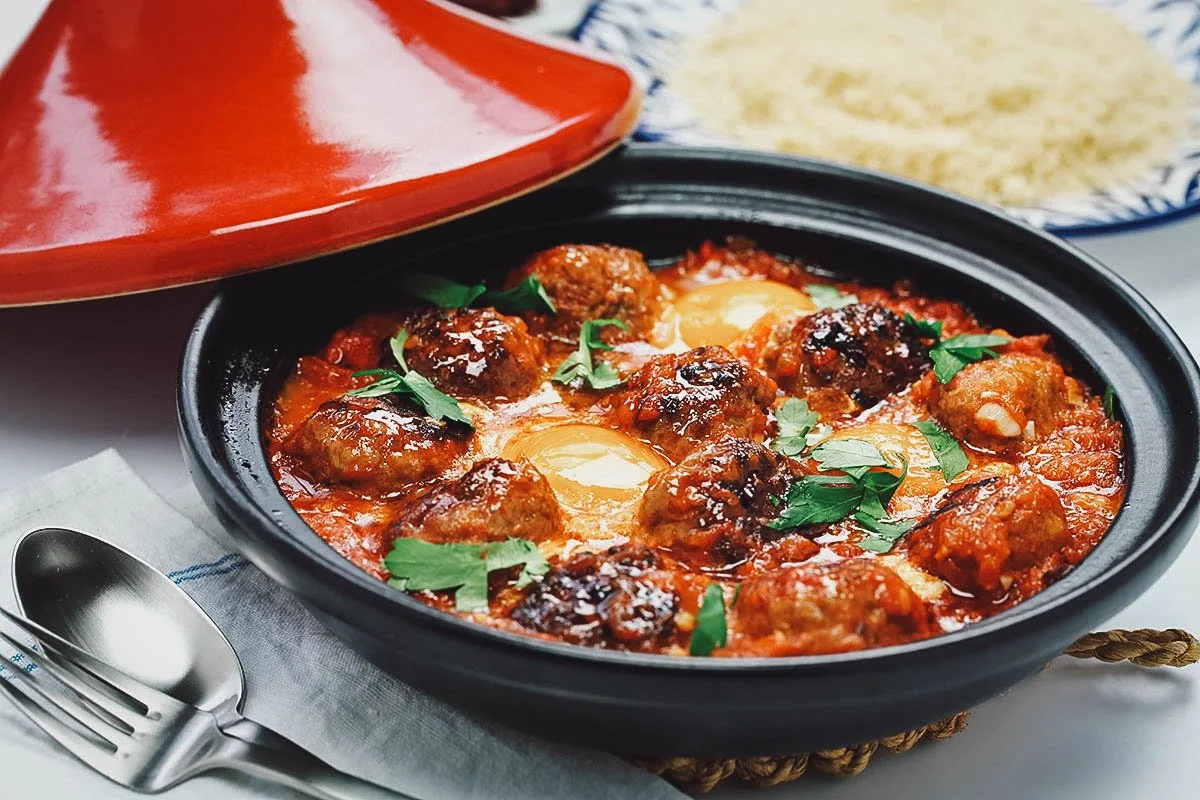
Photo by asimojet
18. Kebabs
Skewered meat dishes are common in many cuisines and Moroccan is no exception. In Morocco, kebabs (or qotban) are typically made with lamb or beef marinated in a mixture containing onions, parsley, olive oil, black pepper, and salt. They’re skewered with alternating cubes of fat to keep the meat moist while being grilled over hot charcoal.
When made with seasoned ground beef or lamb, the dish is known as kefta (or kofta) kebabs.
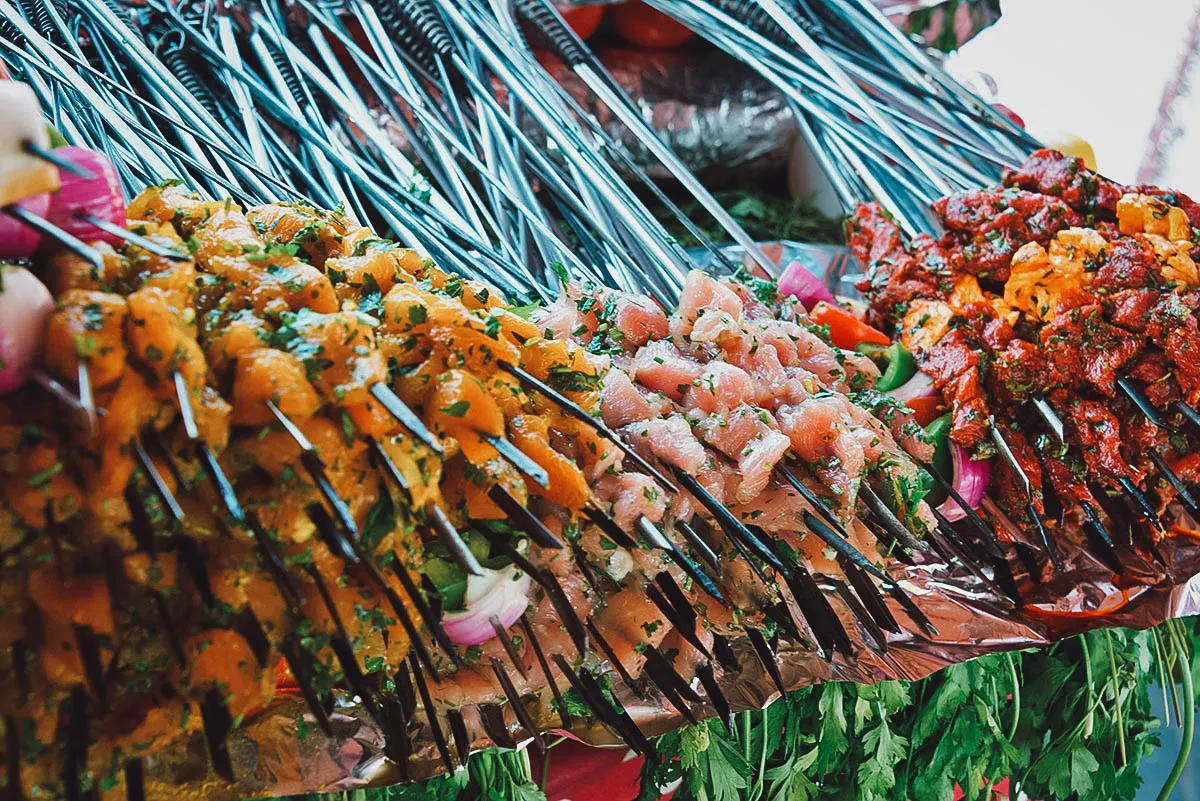
Photo by nikolailink
19. Bastilla
Bastilla (or b’stilla, pastilla) is one of the most well-known dishes in Moroccan cuisine. It’s equally popular in Algeria and refers to a savory pie made with light and crispy warqa dough filled with either poultry or seafood. Originally from Andalusia, the name bastilla is derived from the Spanish word pastilla meaning “small pastry”.
Poultry bastilla is traditionally made with squab but more modern versions are now made with chicken. The bird is browned in butter and simmered with onions, parsley, and various spices like saffron, nutmeg, and ginger till tender. The chicken meat is then deboned and shredded and the simmering liquid reduced and thickened with eggs to form a custard-like sauce.
In a round pan, thin layers of buttered warqa dough are layered multiple times with the sauce and shredded chicken meat. A layer of crushed almonds mixed with sugar and cinnamon is then added at the top before being covered with more layers of buttered warqa dough. The pie is baked till golden brown and sprinkled with powdered sugar, cinnamon, or fried almonds before serving.
Unlike poultry bastilla that has a savory-sweet flavor profile, seafood bastilla is known to be more spicy. It’s made with a filling of fish, squid, and shrimp mixed with vermicelli noodles, black mushrooms, and a spicy tomato sauce.
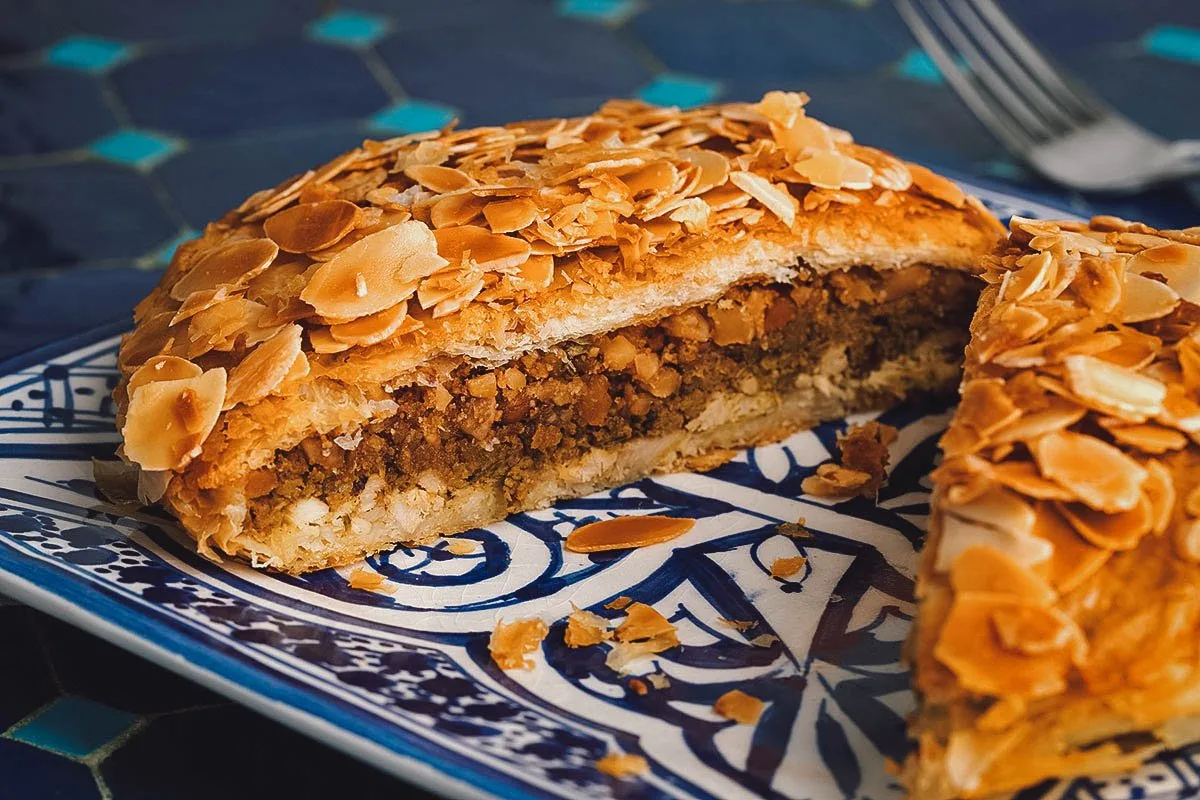
Photo by picturepartners
20. Chicken Rfissa
New mothers need nourishing food and chicken rfissa is proof of that. It refers to a popular Moroccan Berber dish of stewed chicken, lentils, and onions served on a bed of shredded trid pastry. In Morocco, it’s typically given to mothers on the third day after giving birth because of its purported health benefits.
Chicken rfissa is a variation of a centuries-old Arab dish of stew and broth served over bread. It’s made with chicken and lentils stewed with ras el hanout, fenugreek seeds, saffron, and other spices. The chicken, lentils, and broth are traditionally served over a bed of shredded and steamed trid pastry though msemen, meloui, harcha, or even day-old bread can be used as a substitute.
Chicken rfissa is said to be beneficial to new mothers because of the fenugreek seeds. A unique herb long used in alternative medicine, it’s believed to have many health benefits for women recovering from childbirth.
Though chicken rfissa is traditionally prepared for new mothers, it’s a popular dish that’s often made for other occasions and family gatherings as well.
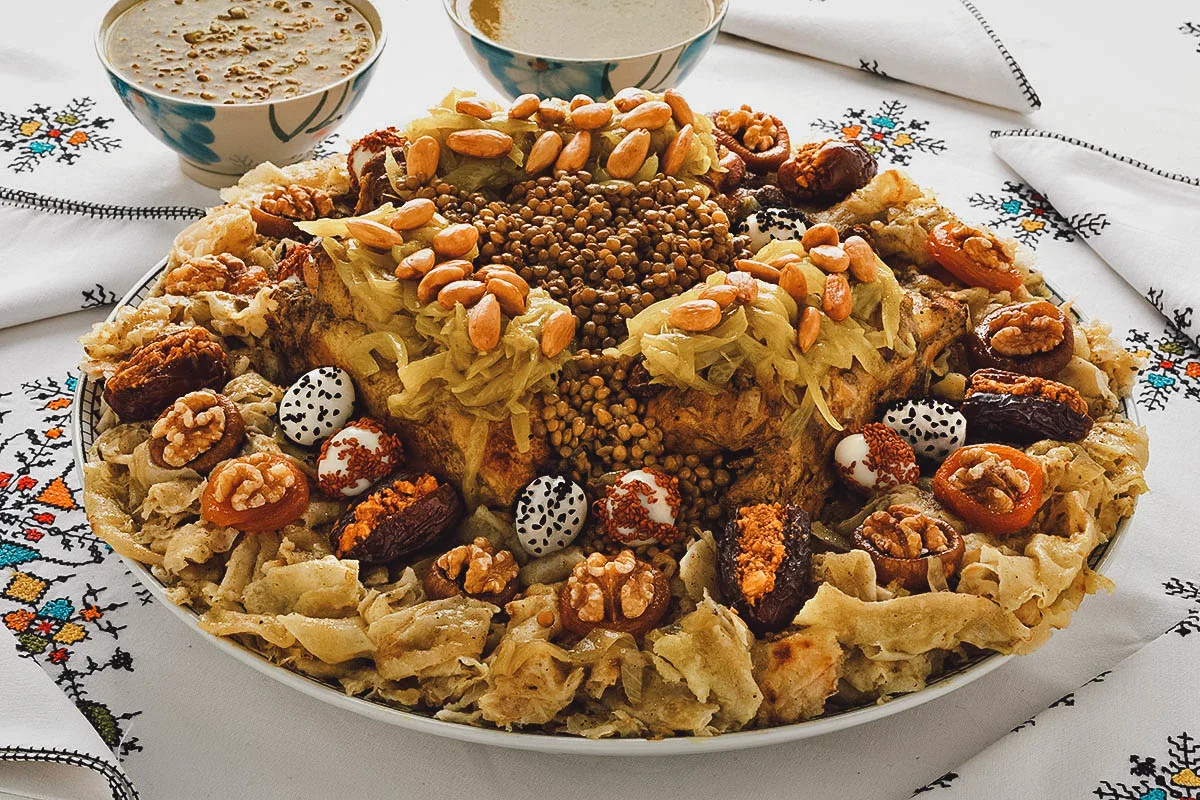
Photo by picturepartners
21. Fish Chermoula
Chermoula (or charmoula) refers to a foundational marinade or relish often used in North African cooking. Popular in the cuisines of Morocco, Tunisia, Libya, and Algeria, it’s traditionally used to flavor fish and seafood dishes though it can be used on meats, poultry, and vegetables as well.
There are many variations of chermoula but it’s typically made with garlic, salt, olive oil, fresh herbs, spices, and an acidic ingredient like vinegar or lemon juice. Recipes vary greatly by region but some of the most commonly used herbs and spices include coriander, parsley, cumin, paprika, harissa, turmeric, and black pepper.
According to one Moroccan food blogger, the chermoula flavor profile is so common in Moroccan cooking that it’s often included in recipes without cooks even realizing it. A good example of this is zaalouk. This beloved eggplant dip is made with many of the same ingredients as a classic chermoula though most recipes don’t mention it.
The name chermoula is derived from the Arabic word chermel, which means “to rub or marinate something with a spice mix”.
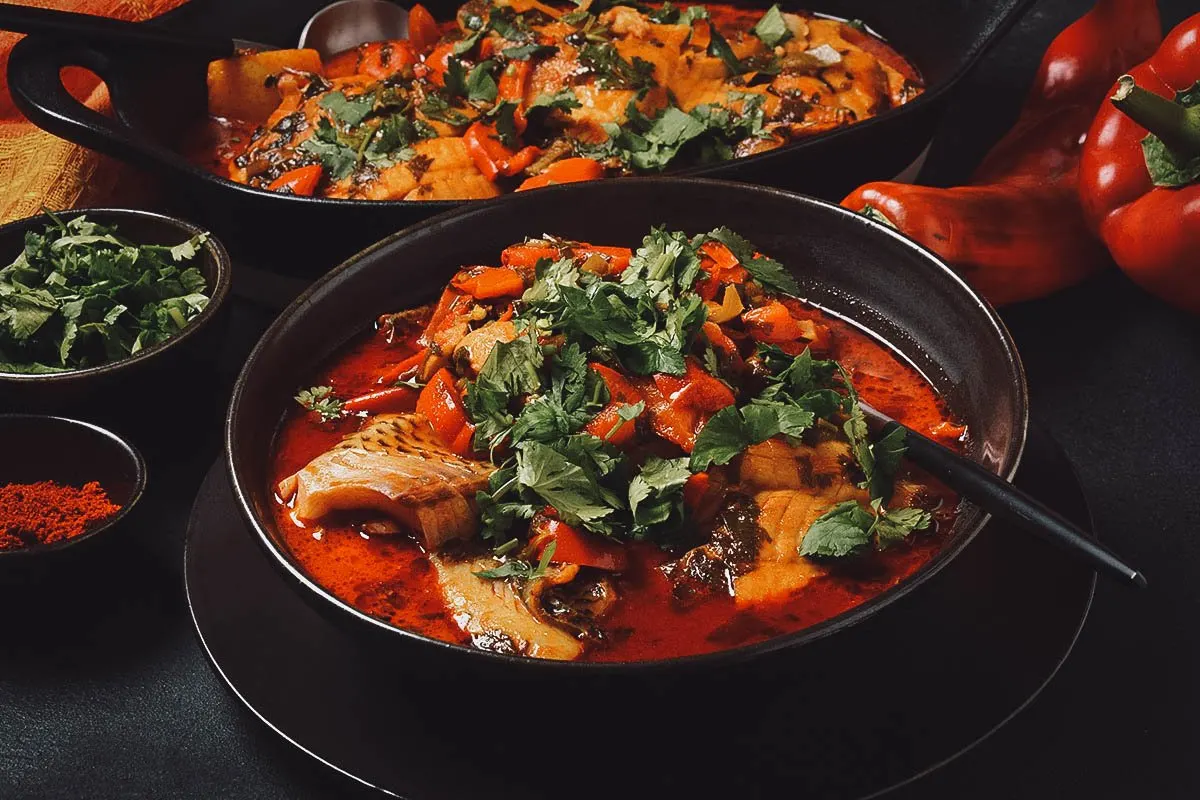
Photo by Nataly1973
22. Stuffed Fried Sardines
Morocco is located on the northwestern coast of Africa. It boasts over 3,000 km (1,864 mi) of coastline and is home to an abundance of fish and seafood, none more important perhaps than the sardine.
Sardines represent more than 62% of the Moroccan fish catch. Morocco processes about 600,000 tons of sardines each year and is the world’s largest exporter of canned sardines.
Being so abundant, sardines are an inexpensive food source in Morocco. They’re a staple food for families living along the coastline and a common ingredient in many Moroccan dishes, one of the most popular being stuffed fried sardines with chermoula.
Stuffed fried sardines is a classic street food in Morocco. It’s made with two butterflied sardine fillets sandwiched together with chermoula, dredged in flour, and then pan-fried.
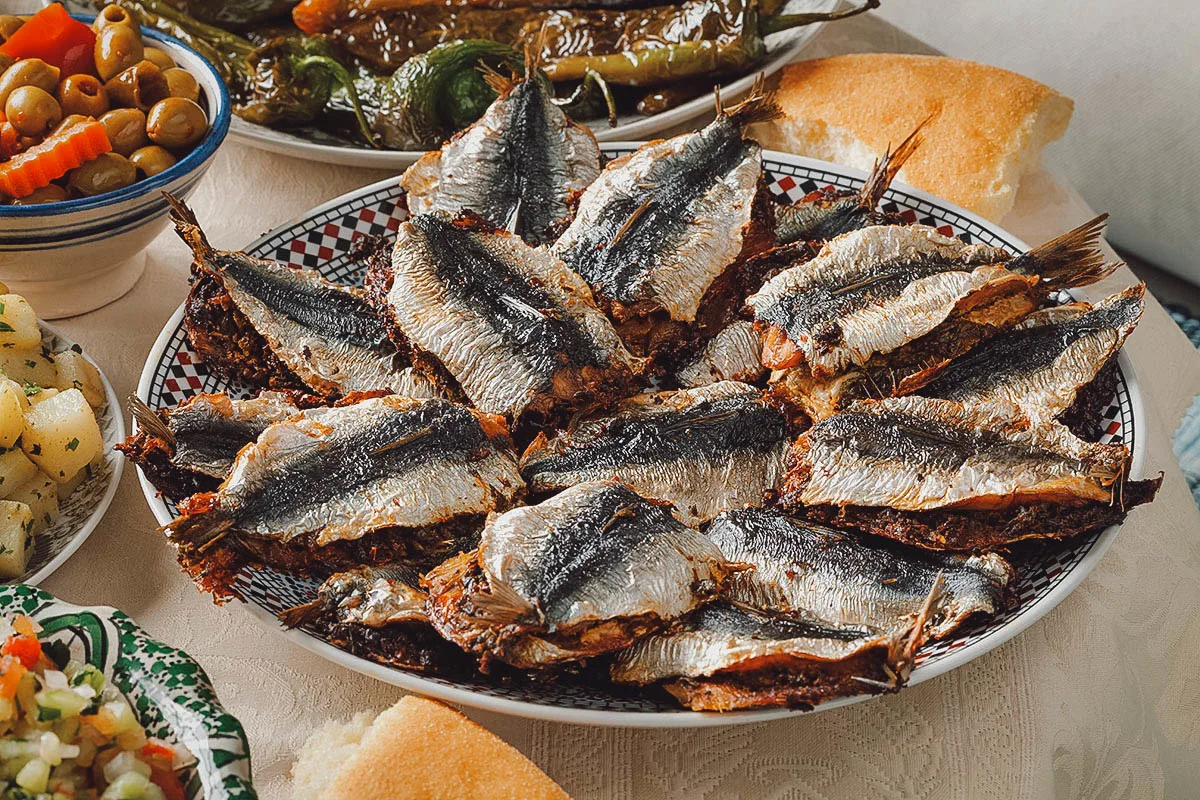
Photo by picturepartners
23. Babbouche
If you’re a fan of Vietnamese ốc, then you’ll surely enjoy babbouche. It refers to a beloved Moroccan street food made with snails cooked in a spiced broth.
Recipes vary from vendor to vendor but babbouche (or ghal) can be flavored with up to fifteen different spices and seasonings like licorice root, aniseed, thyme, lavender, and tea leaves. Served in a bowl with broth and fished out with toothpicks, it’s a type of snail soup that’s especially popular in winter.
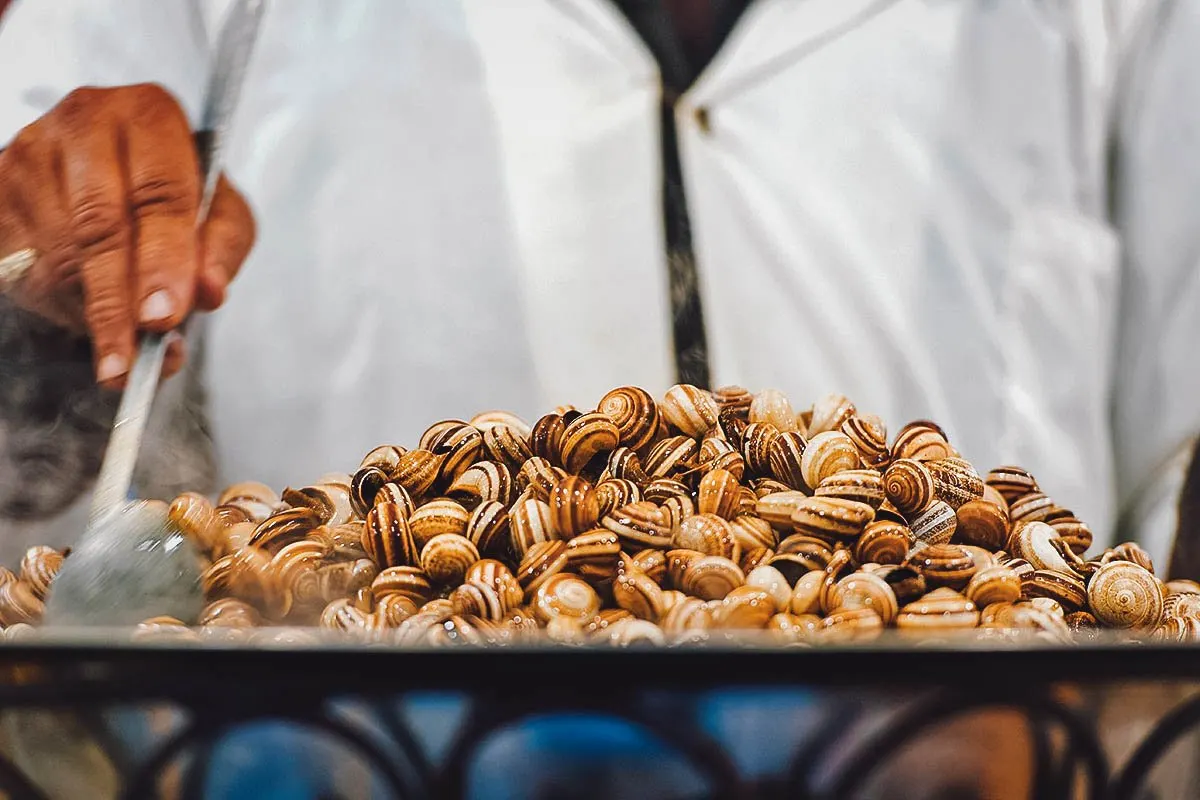
Photo by Savvatexture
DESSERTS / DRINKS
24. Chebakia
Chebakia (or mkharka) refers to a deep-fried Moroccan sesame cookie. It’s known for its floral shape and crunchy texture and is traditionally prepared during the month of Ramadan.
To make chebakia, strips of spiced sesame dough are rolled to resemble roses before being deep-fried till golden brown and crunchy. The cookies are then coated with a syrup made from honey and orange blossom water and sprinkled with sesame seeds.
Chebakia sounds simple to make but folding the dough into the right shape can be time-consuming. Moroccan women would often work together to create large batches which they’d then divide amongst themselves to last through Ramadan.
Like harira, chebakia is traditionally a dish served to break the fast but it’s often prepared to celebrate other occasions as well.
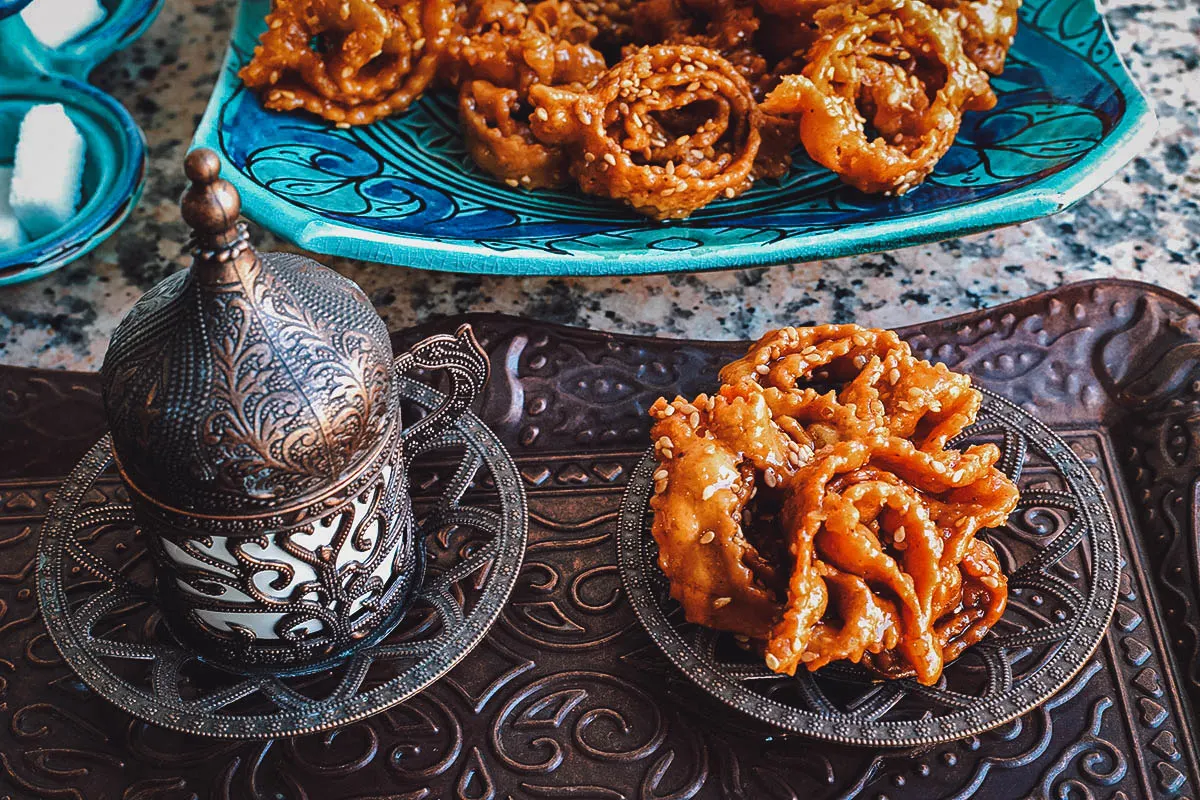
Photo by Nadinlargo
25. Sellou
Like chebakia and harira, sellou is one of the most commonly eaten dishes during Ramadan. Also known as sfouf or zmita, it refers to a unique Moroccan dessert made from roasted flour mixed with butter, honey, fried almonds, toasted unhulled sesame seeds, and spices.
To prepare, the ingredients are blended together to form a thick rich paste which is formed into a pyramid and decorated with almonds. Individual portions are then cut from the pyramid and served on plates.
Because it’s such a nutritious and calorie-packed dish, sellou is considered a natural dietary remedy and often given to nursing mothers to increase lactation. For this reason, nursing Moroccan women are advised to consume sellou for at least thirty days after giving birth.
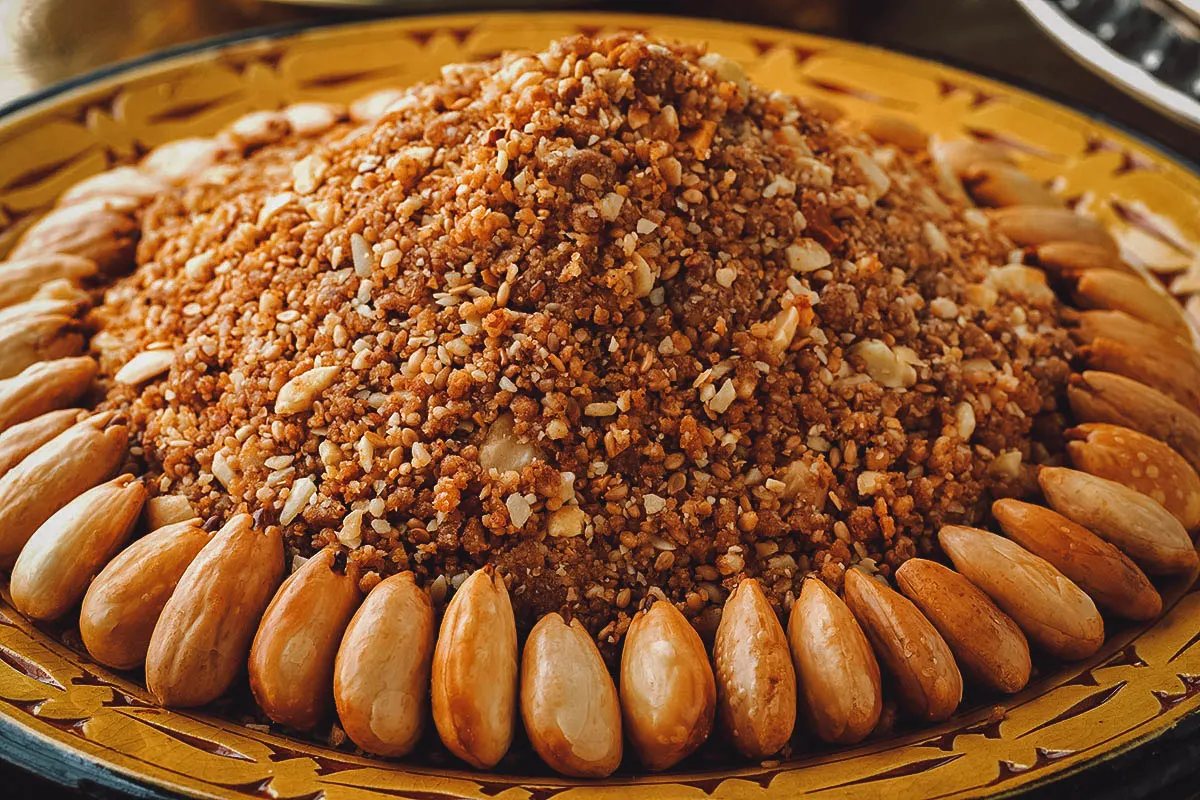
Photo by picturepartners
26. Kaab el Ghazal
Kaab el ghazal (or cornes de gazelle in French) refers to these crescent-shaped cookies popular in the cuisines of Morocco, Algeria, and Tunisia. Frequently served on special occasions, the name literally translates to “gazelle ankles” though they’re more commonly referred to as “gazelle horns”.
Gazelle horns are made with a flour-based dough filled with almond paste mixed with cinnamon and orange blossom water. They’re baked till lightly golden and then dipped in orange blossom water before serving. When dusted with powdered sugar, they become known as kaab el ghazal m’fenned.
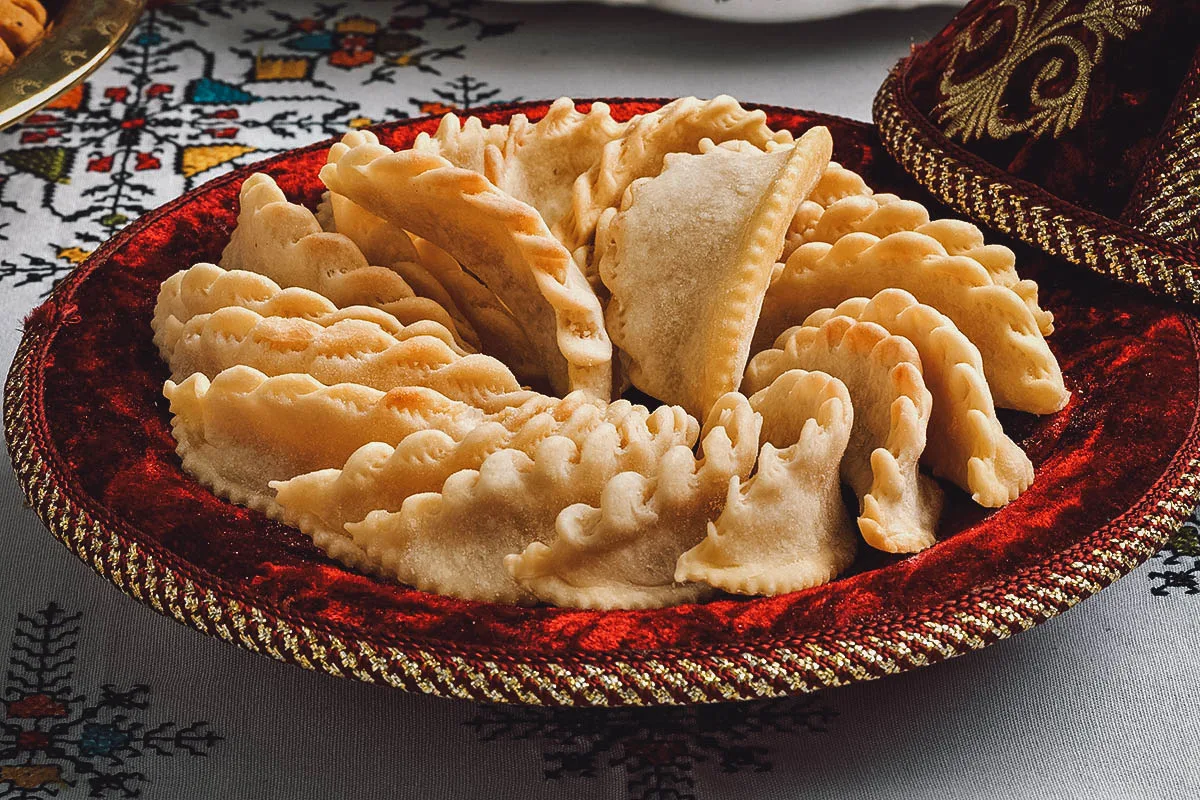
Photo by picturepartners
27. Ghoriba Bahla
Ghoriba refers to a type of Moroccan shortbread cookie made with ground almonds and toasted sesame seeds. They can be made in many different ways but one of the most common is ghoriba bahla, a version known for the distinctive cracks that form on its surface.
What seem like imperfections or accidents are highly desirable in ghoriba cookies. The cracks indicate that the cookie was made with the right ratio of ingredients and thus possess the desired texture. Without these cracks, a cookie can only be called ghoriba and not ghoriba bahla.
Oddly enough, the word bahla translates to “silly” in Moroccan Arabic. No one really knows why.
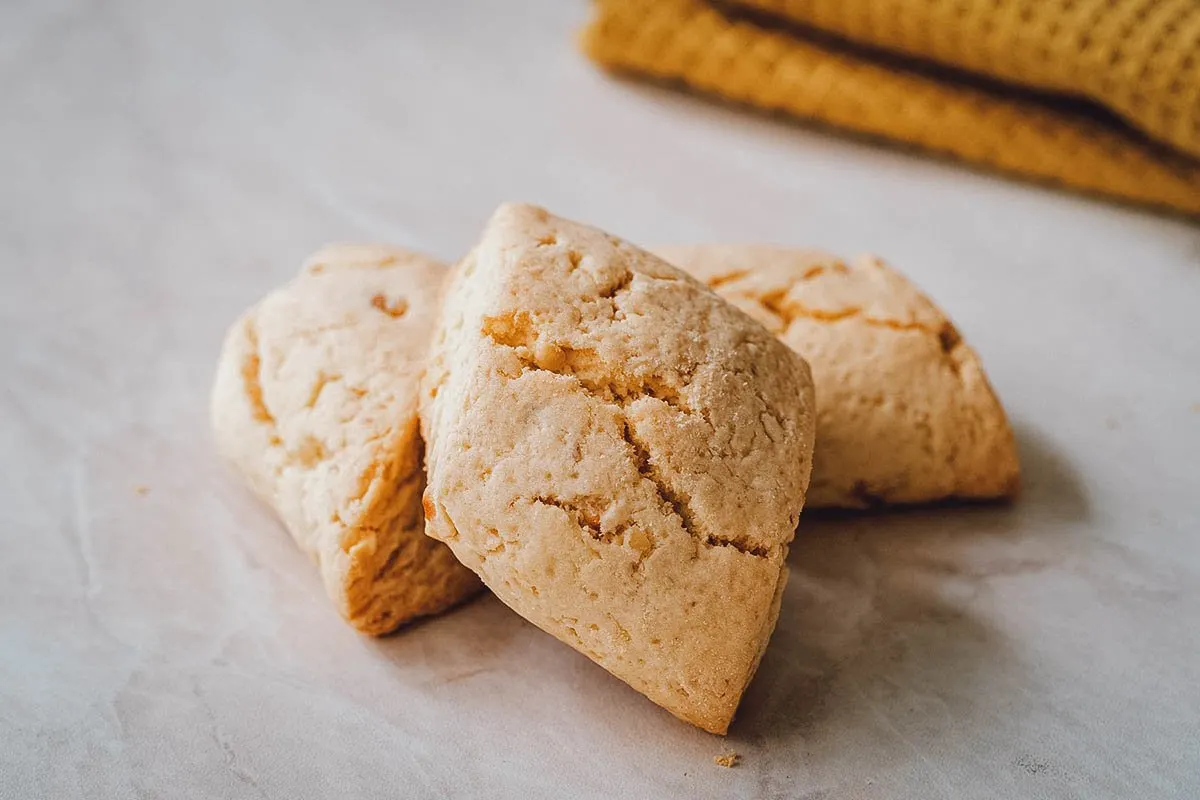
Photo by Alp_Aksoy
28. Kaak d’Essaouira
Named after the coastal city of Essaouira, kaak d’essaouira refers to a Moroccan cookie made with flour, anise, sesame seeds, orange blossom water, vanilla, salt, and sugar. Made without eggs, it’s a type of vegan cookie that’s commonly sold as street food throughout Morocco.
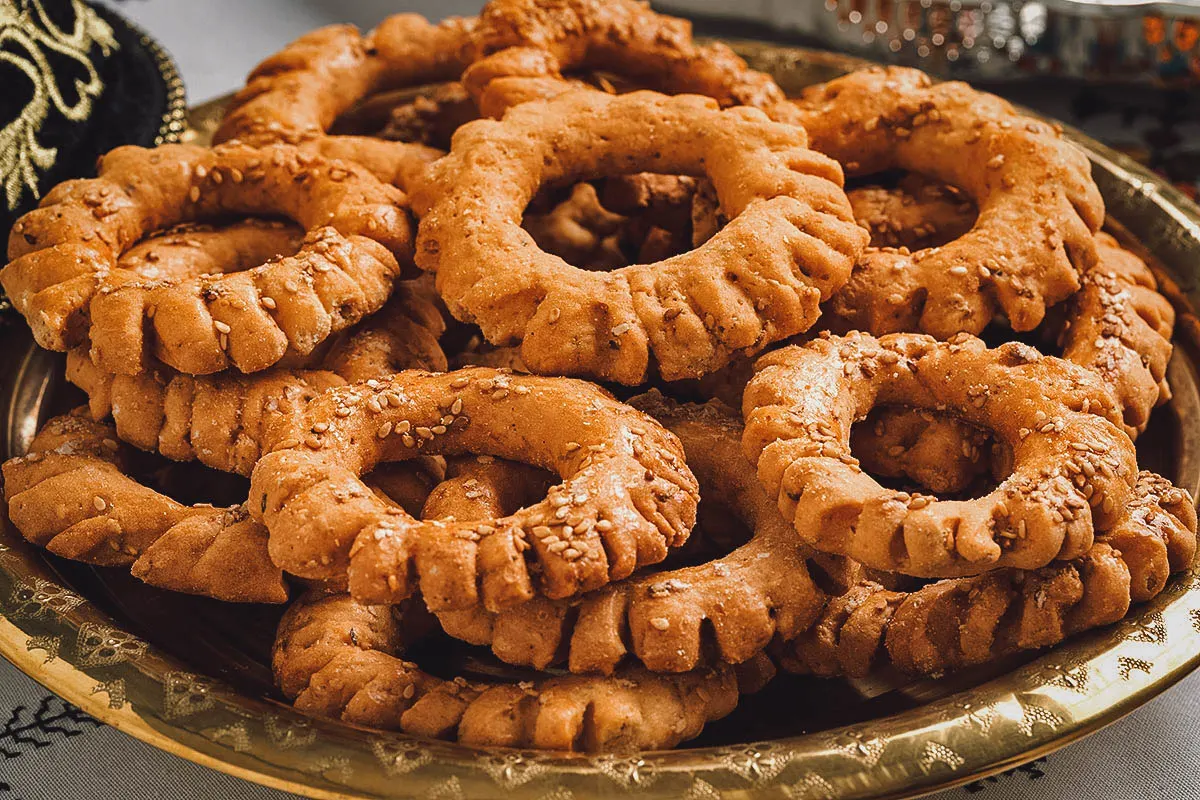
Photo by picturepartners
29. Sfenj
Doughnuts are a common dessert in many cuisines and Morocco is no exception. Sfenj (or sfinj) refers to a type of Maghrebi doughnut made from sticky unsweetened leavened dough. A popular street food in Morocco, they’re chewy and fluffy and can be eaten as is, sprinkled with sugar, or soaked in honey.
Sfenj are believed to be Andalusian in origin and are said to be the inspiration for French beignets. Outside of North Africa, they’re often consumed by Moroccan and Sephardic Jews to celebrate Hanukkah.
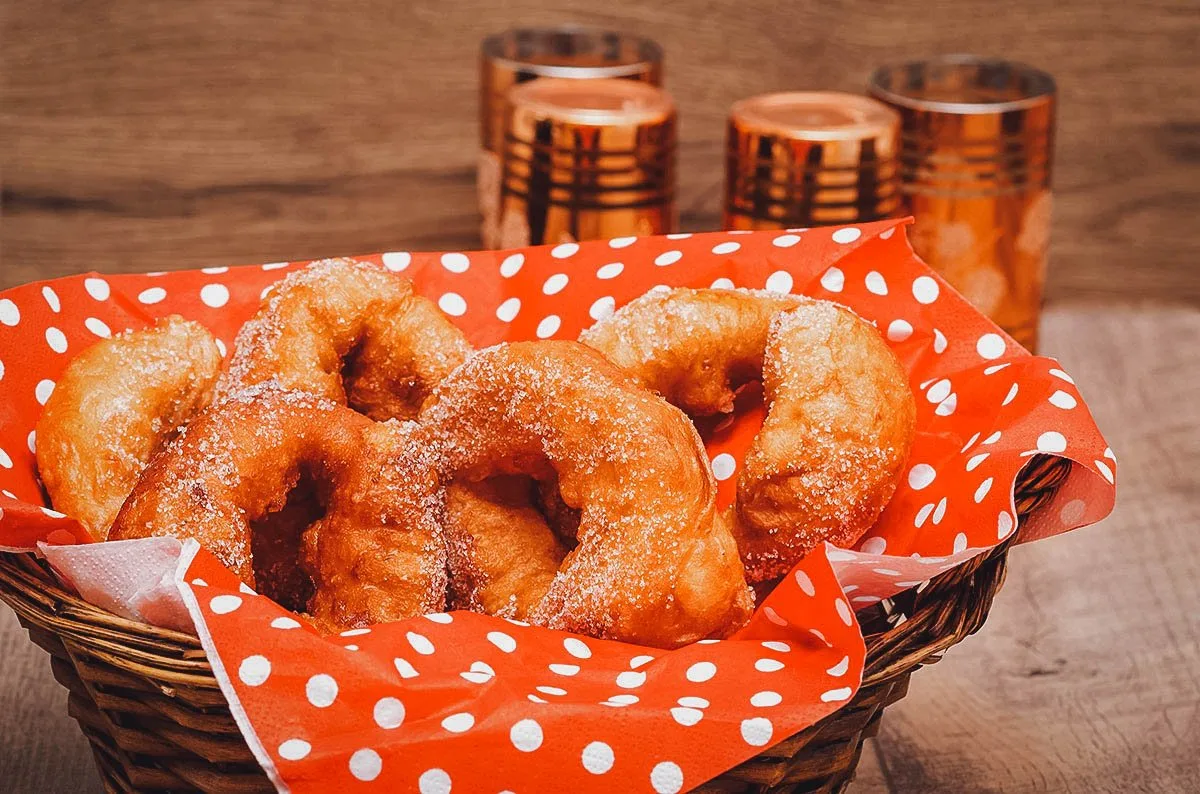
Photo by natushm
30. Mint Tea
If you’re looking for something to pair with these delicious Moroccan desserts, then look no further than mint tea, a type of Moroccan tea made with a green tea base, spearmint leaves, and sugar. It’s an emblematic drink and a central component to social life in the Maghreb.
Like Ethiopian coffee or Argentinian mate, the preparation and serving of Moroccan mint tea is steeped in ritual. It’s traditionally made by the head male of the family and offered to guests as a sign of hospitality. The tea is poured into glasses from a height to gently aerate the tea and improve its flavor.
Mint tea is typically consumed throughout the day as a social activity in Morocco. Traditionally, it’s served three times per brewing. The amount of time it spends steeping gives each glass a different flavor, hence the Maghrebi proverb:
“The first glass is as gentle as life, the second is as strong as love, the third is as bitter as death.”
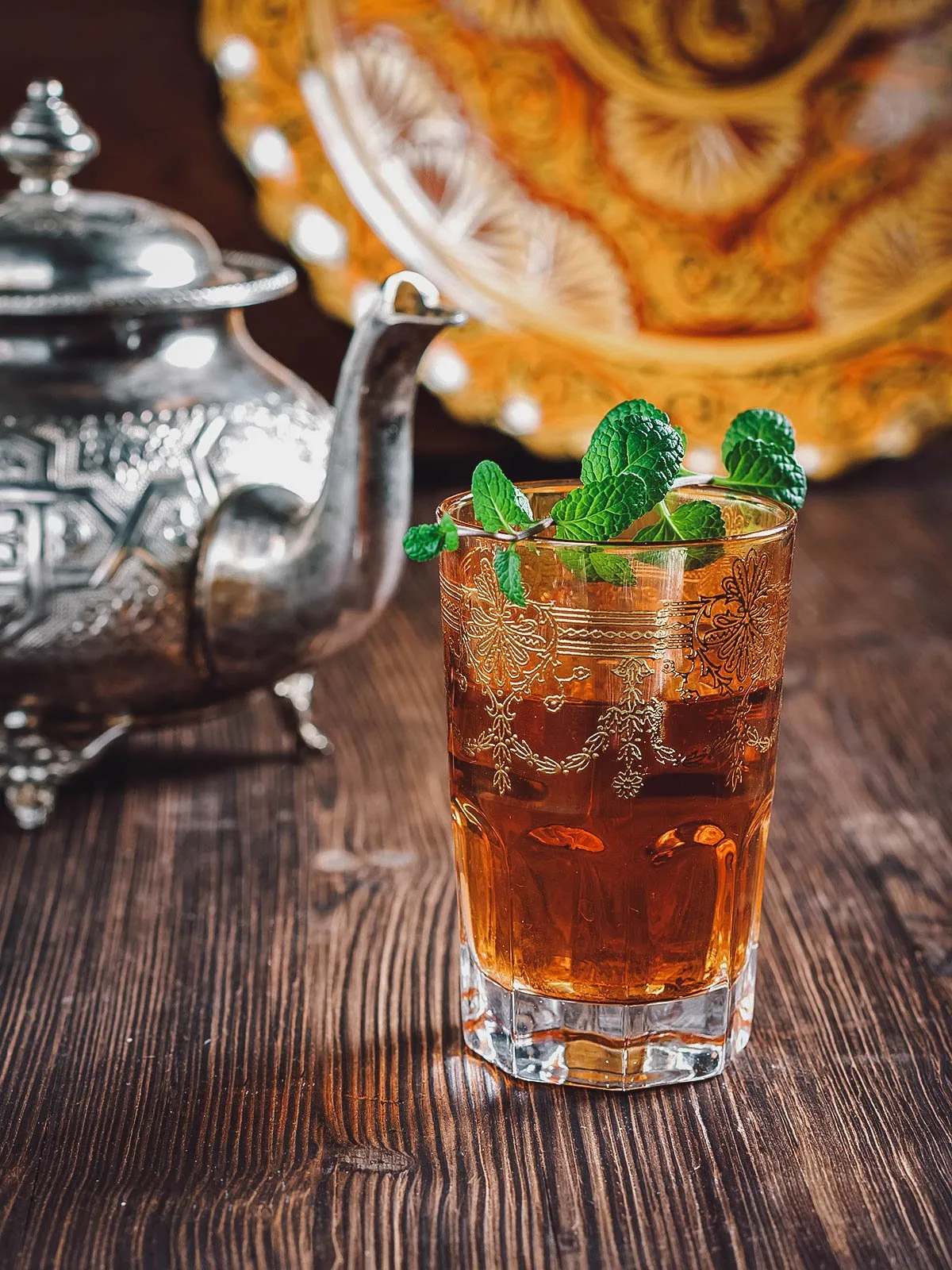
Photo by Seagull_l
MOROCCAN FOOD TOURS
With so many intoxicating flavors and aromas to try in Morocco, what better way to get the full Moroccan experience than by going on a food tour? Not only will a knowledgeable guide take you to the city’s best markets, street food stalls, and restaurants in Marrakesh, but they’ll be able to explain all the Moroccan dishes to you in more detail as well.
Check out Get Your Guide for a list of Moroccan food tours in Marrakech, Tangier, Fes, and other cities throughout the country.
MOROCCAN COOKING CLASSES
Eating Moroccan food is one thing, but learning how to actually make it yourself is another. In my opinion, taking a cooking class is one of the best ways to learn about the local cuisine. It’s like looking under the cuisine’s hood.
If you want a more hands-on experience with Moroccan food, then check out Cookly for a list of cooking classes in different cities throughout Morocco.
FINAL THOUGHTS ON MOROCCAN CUISINE
With its many souks, spices, and medinas, Morocco truly is a feast for the senses. It’s an intoxicating blend of sights, smells, and sounds that’s sure to capture the hearts and imaginations of many travelers, especially those who travel for food.
This Moroccan food list is by no means a definitive guide but we hope it whets your appetite and gets you even more excited to experience the unique flavors of Morocco.
Disclosure
Some of the links in this article on Moroccan foods are affiliate links. If you make a booking, then we’ll earn a small commission at no additional cost to you. As always, we only recommend products and services that we use ourselves and firmly believe in. We really appreciate your support as it helps us make more of these free travel and food guides. Thank you!
Cover photo by tomasadzke. Stock images via Depositphotos.


amelia
Thursday 26th of October 2023
We are very grateful to Sahara Morocco Travel for our recent wonderful trip to Morocco. We travelled as a family group of 4 adults and 1 teenager and booked a 10-day private tour starting in Marrakech, travelling through the High Atlas mountains over the Tichka pass, visiting Ait Benhaddou Kasbah, Dades Gorge, Todra Gorge, continuing into the Sahara at Erg Chebbi and then travelling to Midelt on our way to Fes. A truly fascinating and wonderful holiday. In preparing for this holiday we contacted a number of tour operators, read many reviews and found Said of Morocco Countryside Tours to be the most informative and responsive at this stage of planning so we chose this tour operator. The itinerary was tailor-made and included all our requests as we were interested in learning more about the Berber/Amazigh culture and as Sahara Morocco Travel is run by a Berber family this was a great advantage. We found ourselves in very experienced hands with this family-run tour company. The beauty of this country, the excellent riad accommodation, the authentic experiences with nomadic and Berber families who are very hospitable and have a great sense of humour (just like the Irish :) the fascinating tours in Marrakech with Ali, in Fes with Addi, at Kasbah Amridil and Volubilis with guides, the camel ride in the Sahara, meeting the desert nomadic families and the hospitality of Fatima and her family, watching the sunset and then spending time under the starry desert sky - so lovely. Throughout this wonderful tour of Morocco, our driver and guide (and now friend) Hamid looked after us so well, taking us everywhere safely, with his Amazigh friendliness and sense of humour and cultural knowledge, and of course, his patience as we tried to speak a few words and phrases in the Berber language each day :) We would have no hesitation in recommending a trip to Morocco with the Sahara Morocco Travel - a truly wonderful experience - thank you.
Lia
Friday 26th of May 2023
Chakchouka is not Yemeni nor Middle Eastern. By Middle Eastern do you mean Israel? This is a North African dish that was taken to foreign land such as Israel/Palestine. I’m still unsure what Yemen has to do with anything, they are not connected to us. Most of the food you mentioned are largely Moroccan which spread to Algeria & Tunisia. Chakchouka is Tunisian, it may have been the Tunisian Amazigh and non-Amazigh Jewish community that has popularised this, this would have reached Israel through the migrants. Also we are Amazigh (singular) and Imazighen (plural). I like how you kept your article simple for other people to follow. Other than the references mentioned, I enjoyed reading your article, thank you for sharing your wonderful work. 🫶🏼
JB & Renée
Sunday 28th of May 2023
Thanks so much for the insightful comment Lia! I'll be sure to make corrections to the article in the next update. Cheers!
Hannah
Thursday 30th of March 2023
please don't refer to Amazigh as Berber. It is a word colonialists came up with because they considered this folk as "barbaric".
Khadija
Monday 27th of February 2023
The kaak in the photo is from Oujdaa city located in the northeast of Morocco not from Essaouira ! The kaak of Essaouira and Safi are different from this one.
JB & Renée
Wednesday 29th of March 2023
Thanks for letting us know Khadija!
Kathy Mahan
Tuesday 23rd of August 2022
Could you please recommend a Moroccan cookbook? I have made several dishes and I would like to try more.
JB & Renée
Friday 26th of August 2022
Hi Kathy, I often reference this website for Moroccan recipes. She has an article on recommended Moroccan cookbooks. Hope that helps!